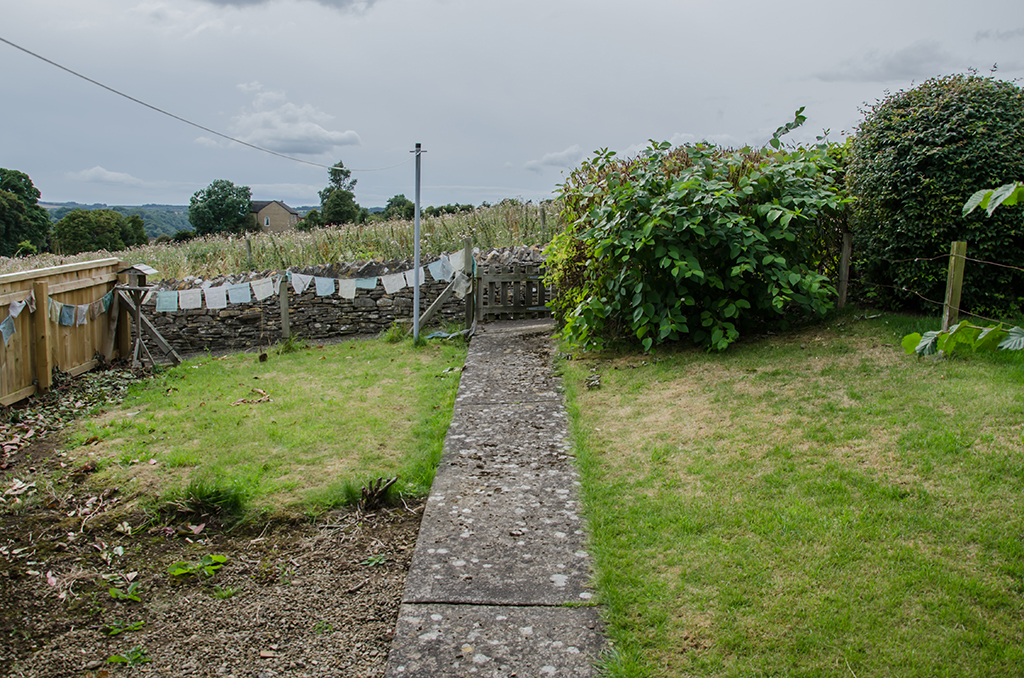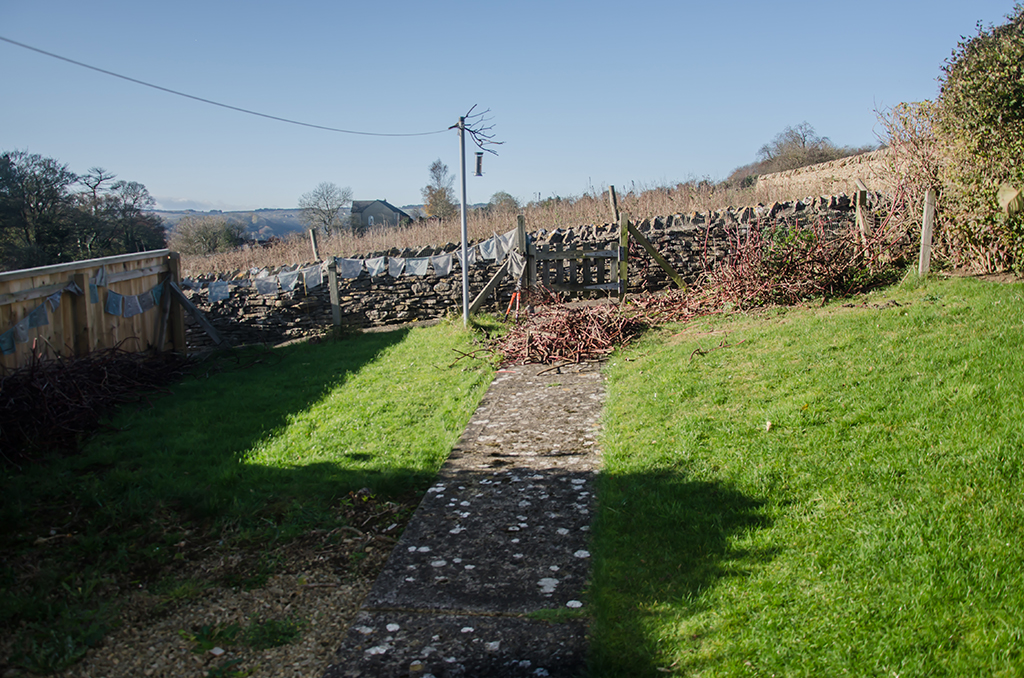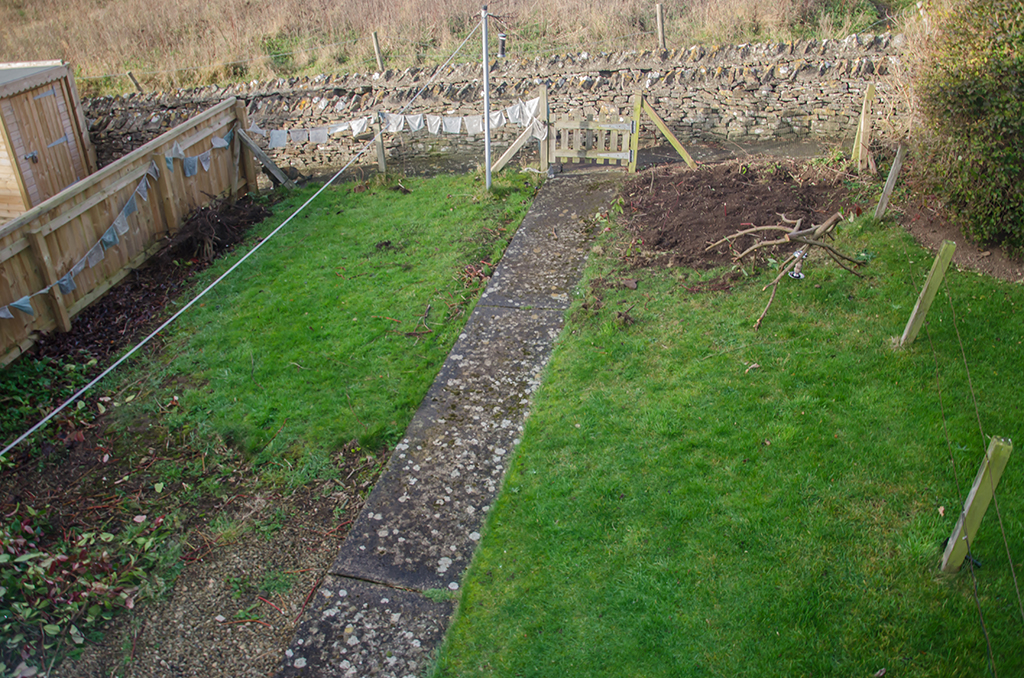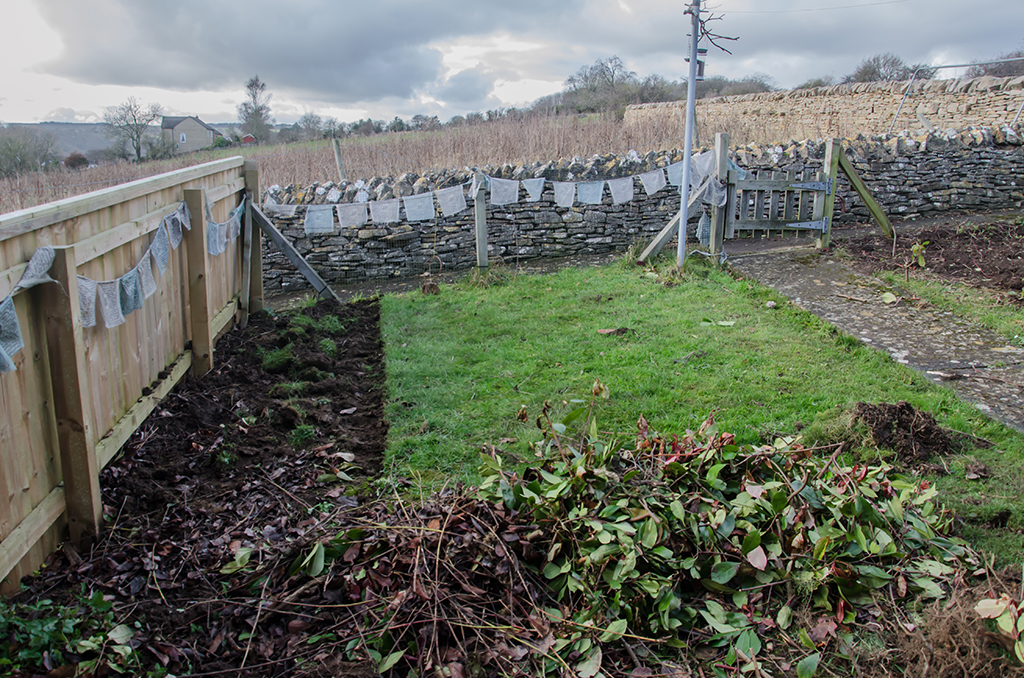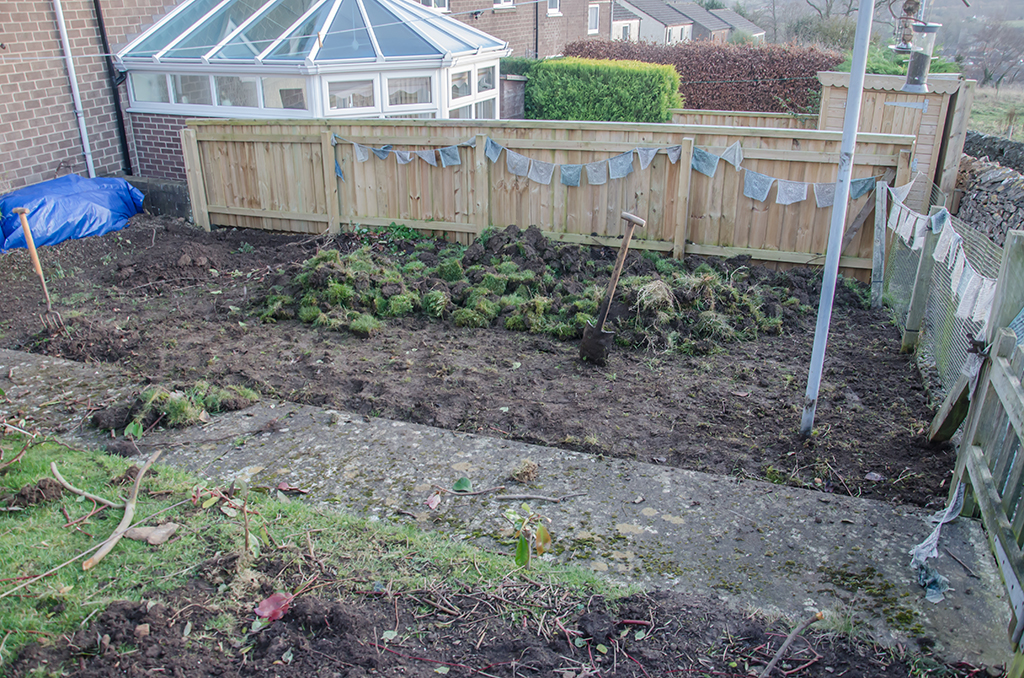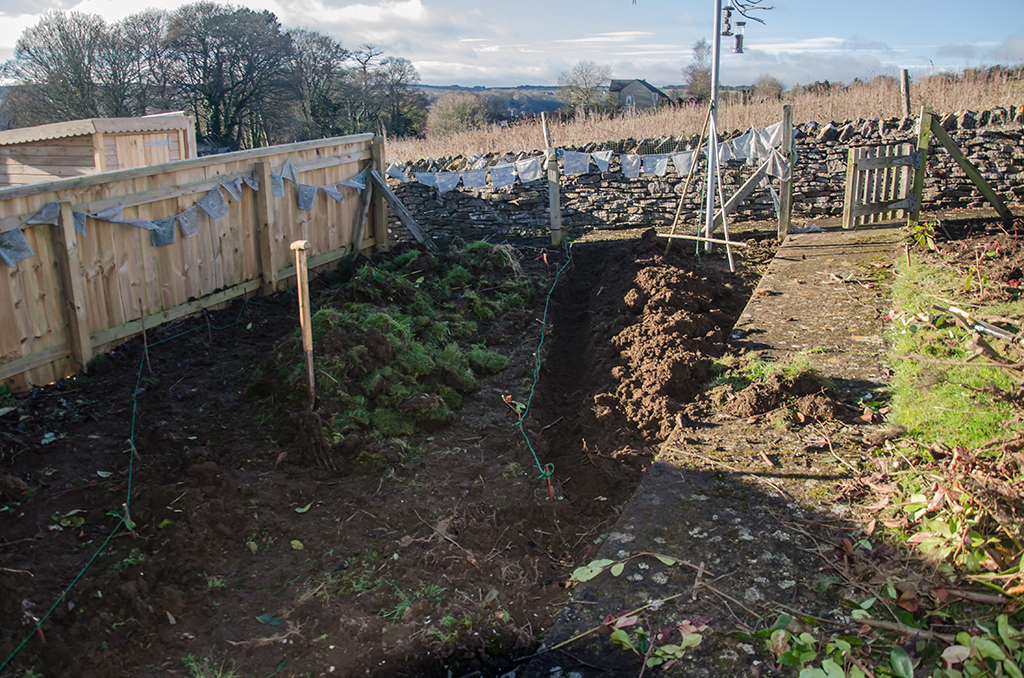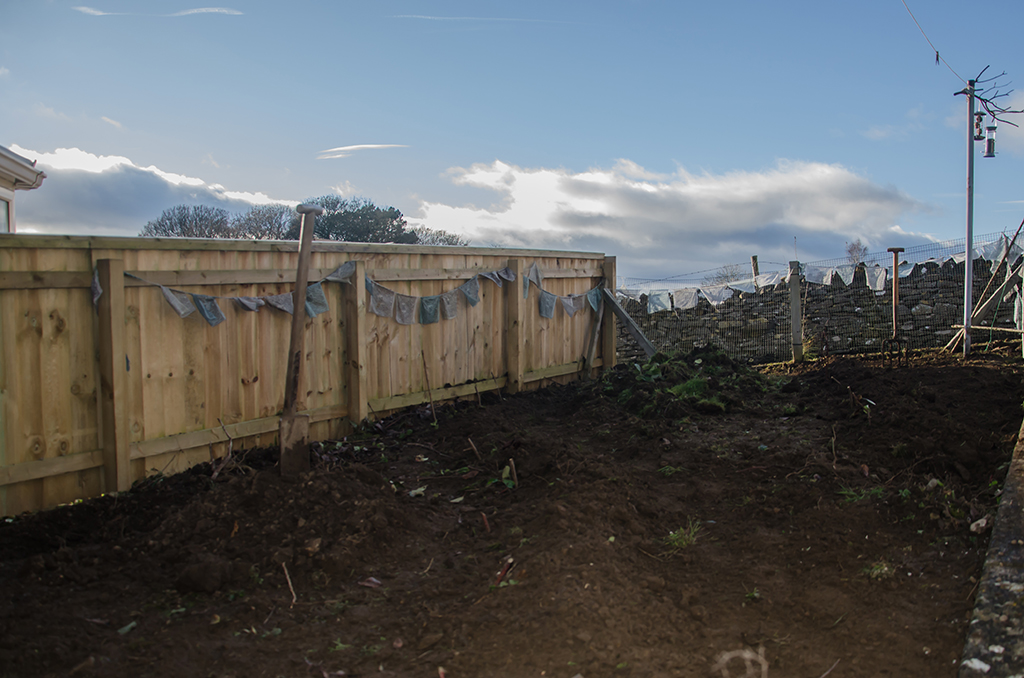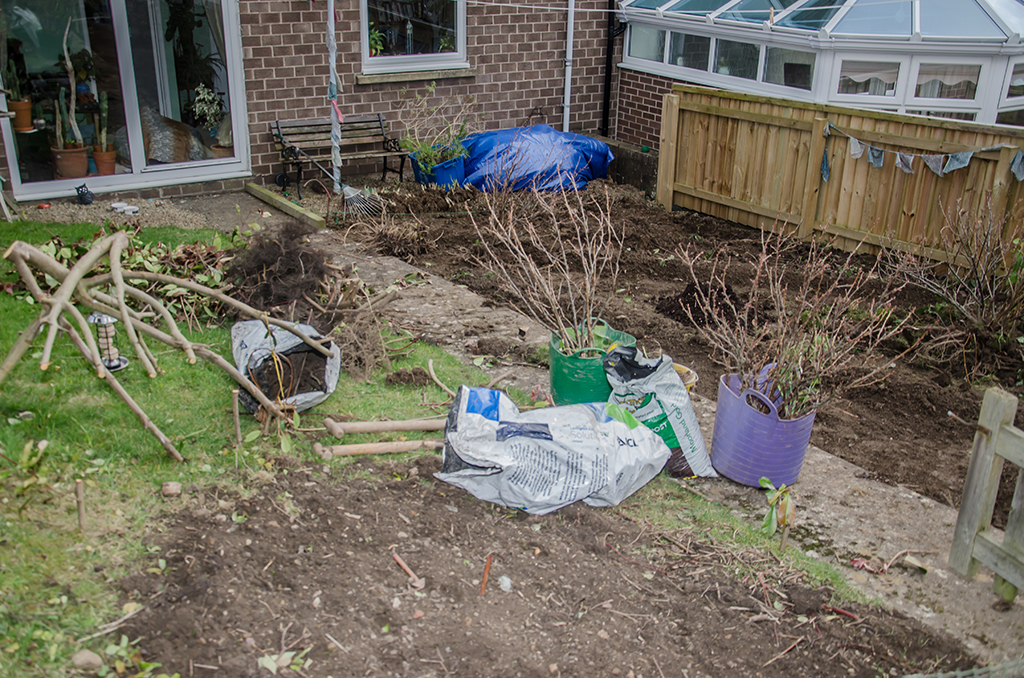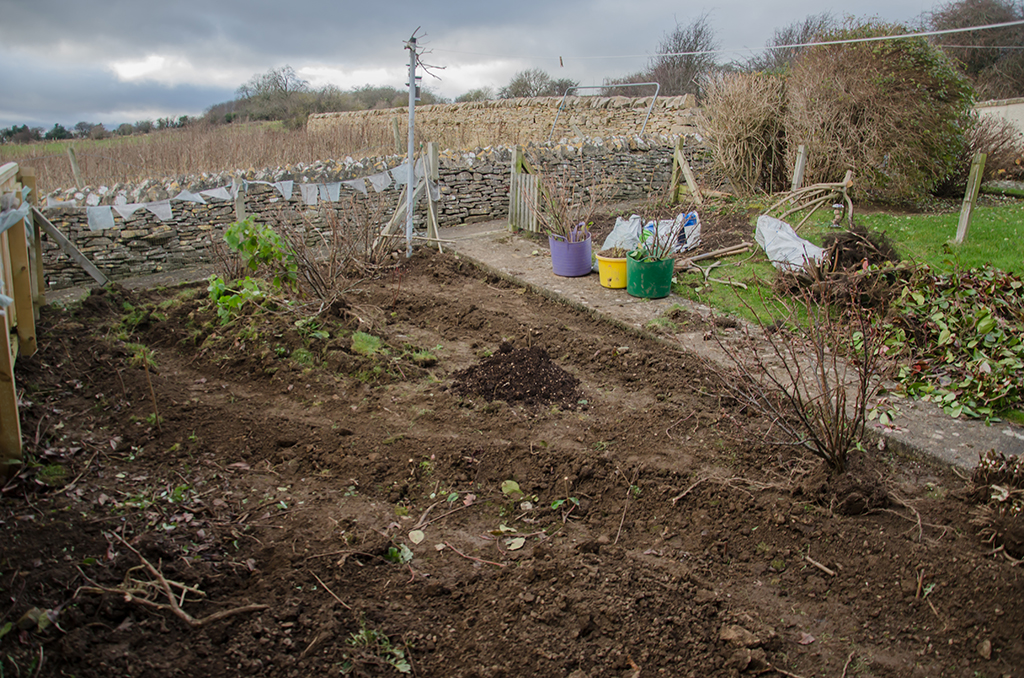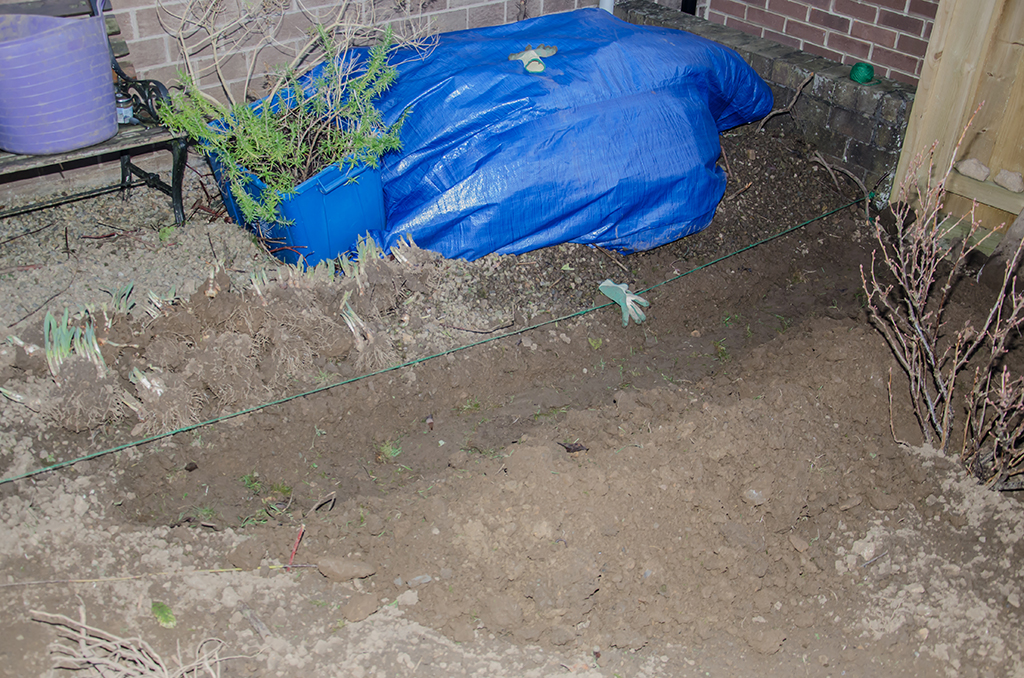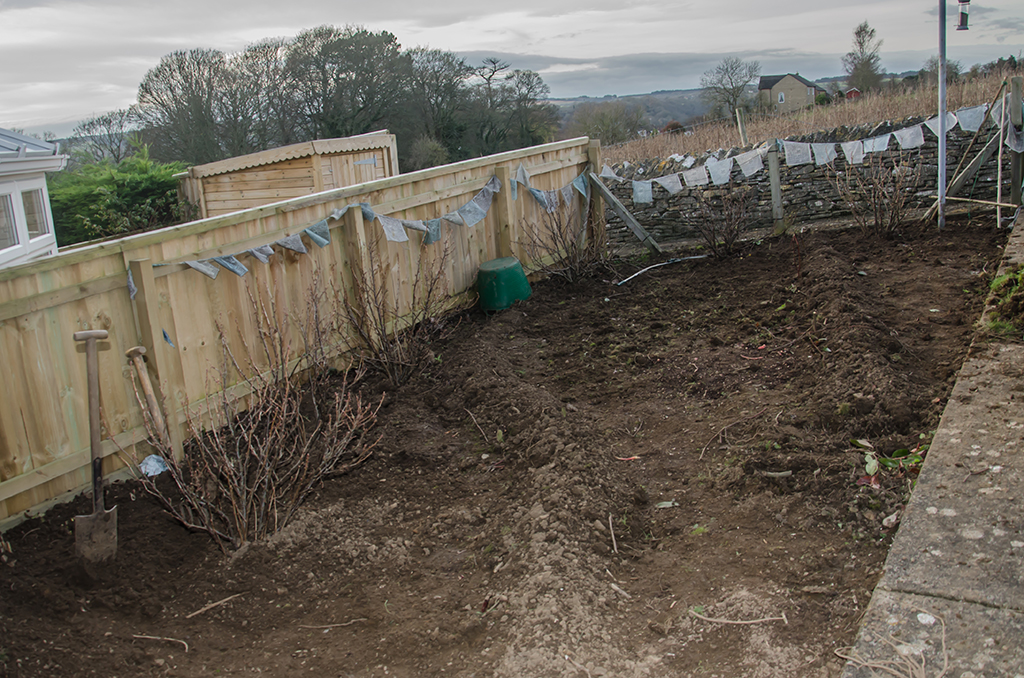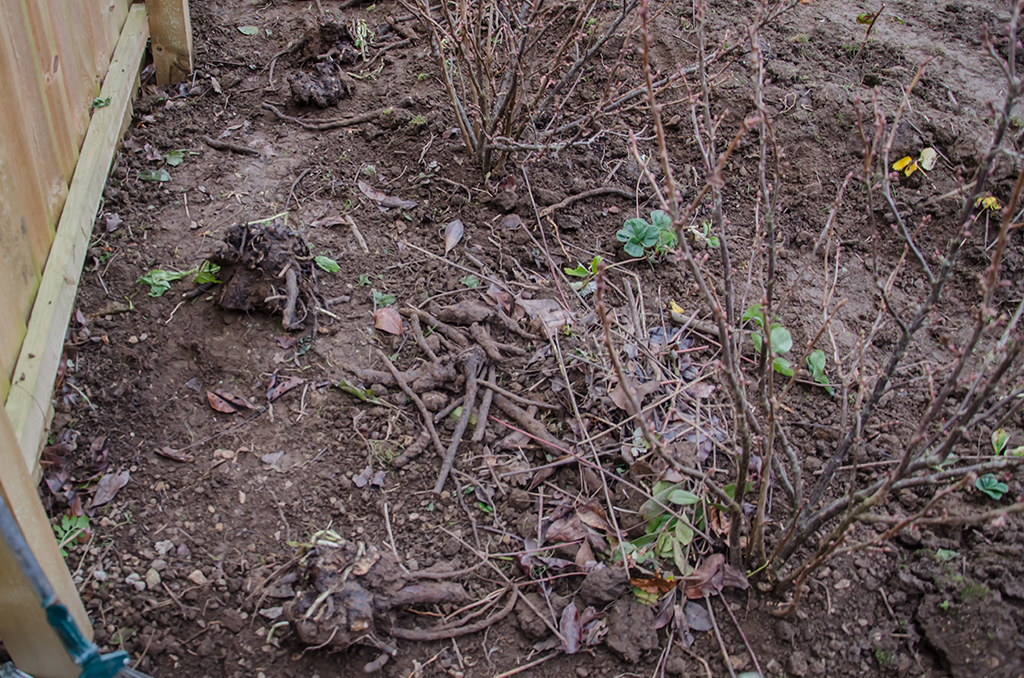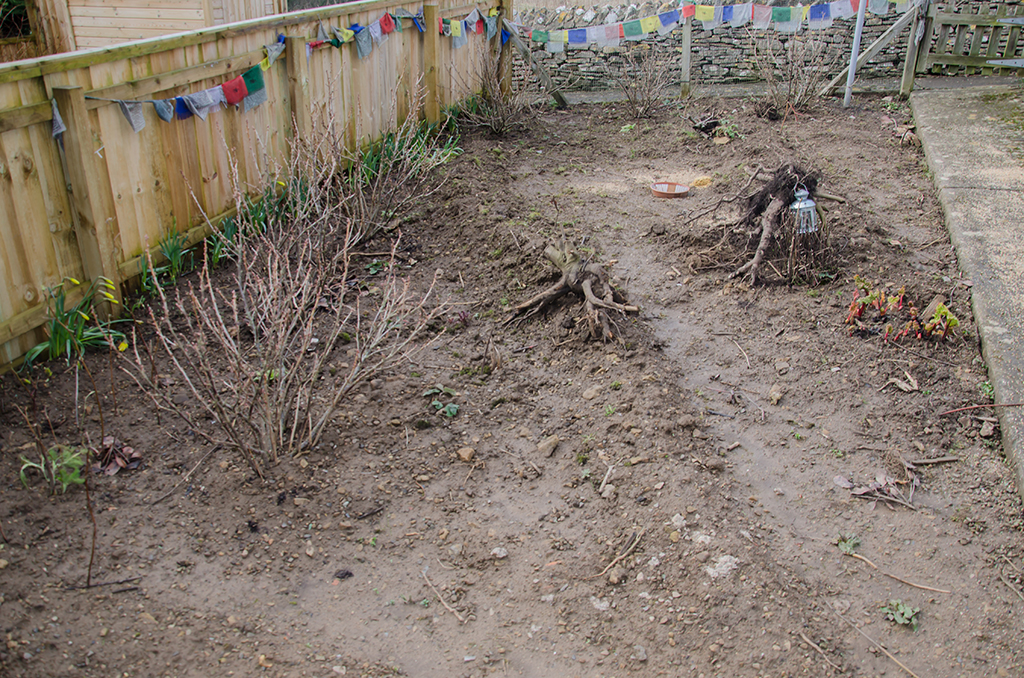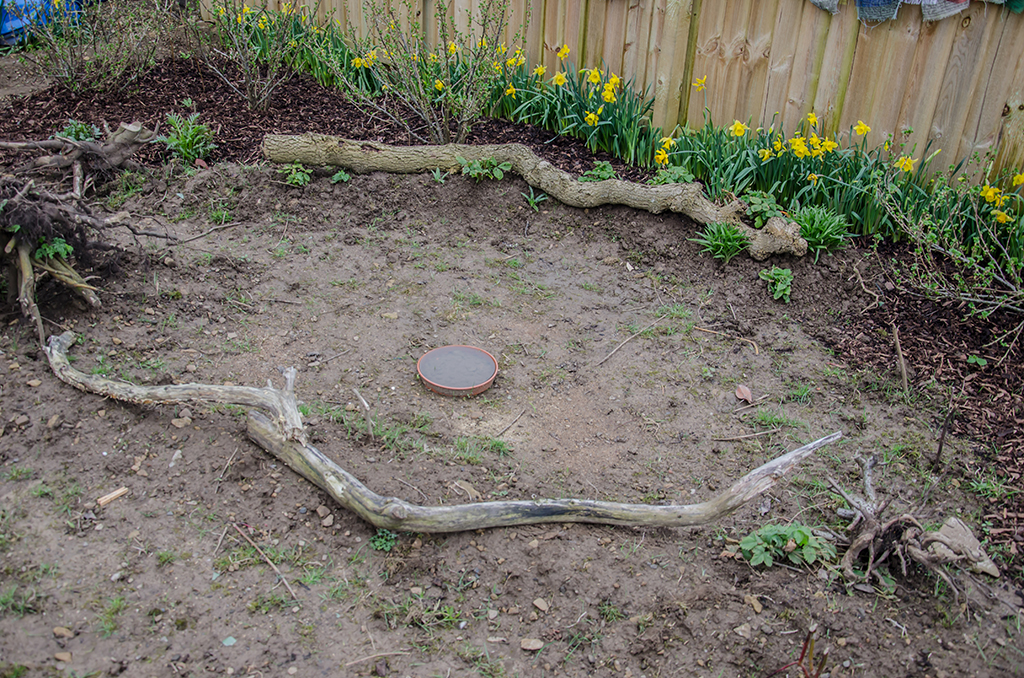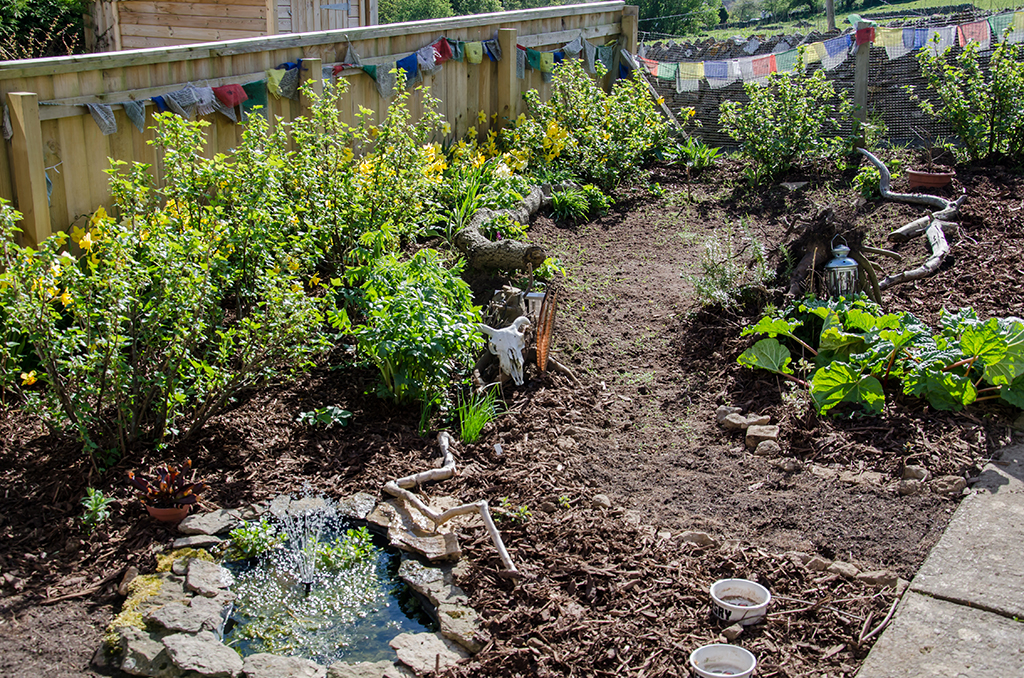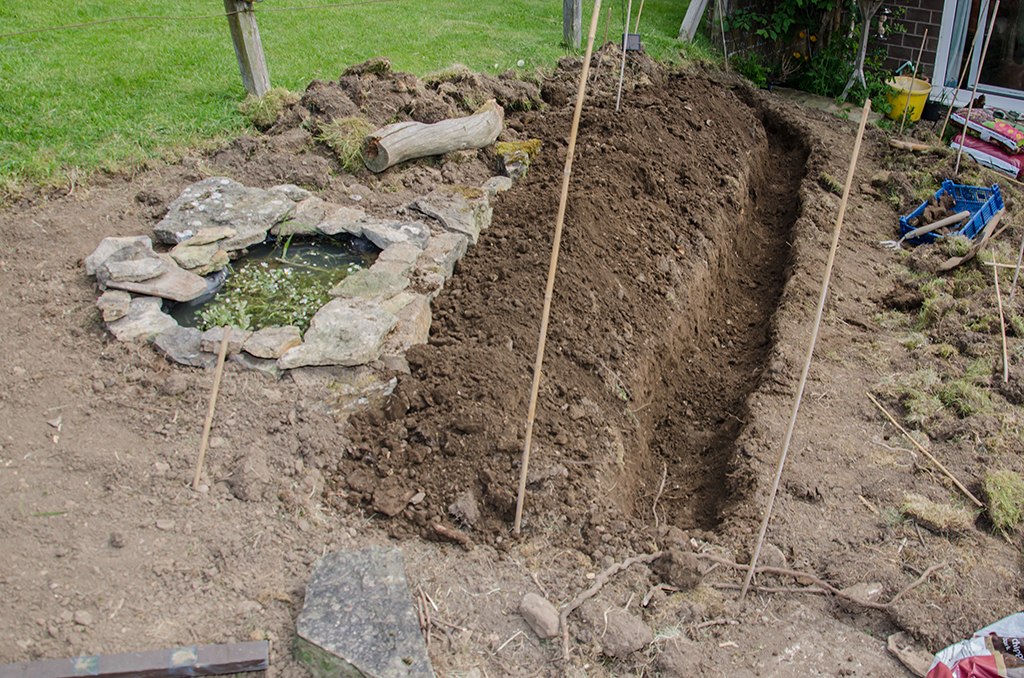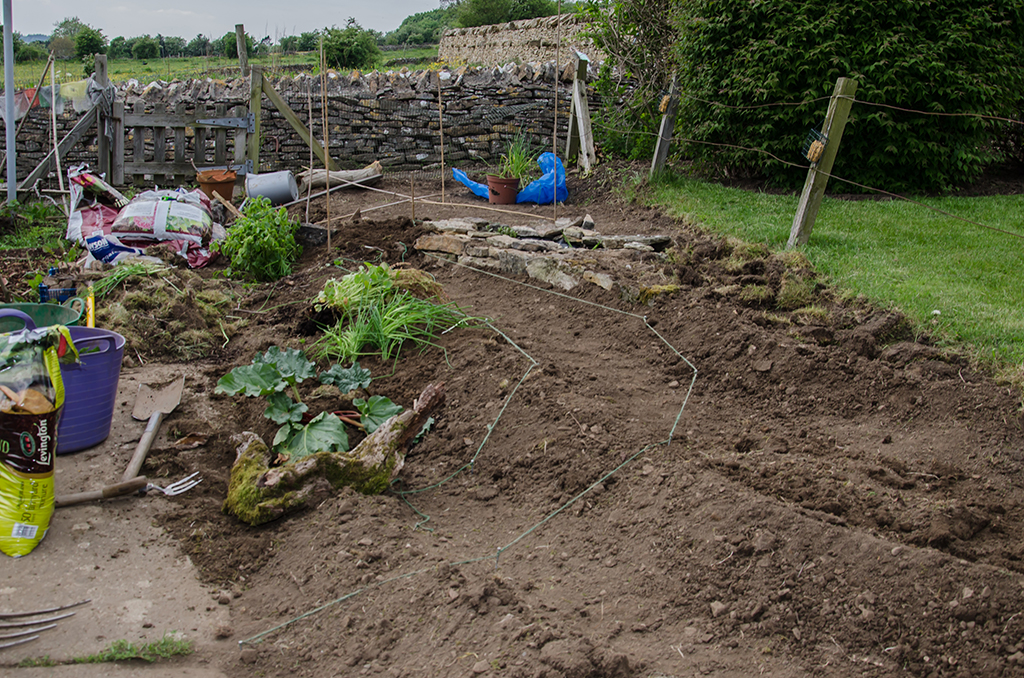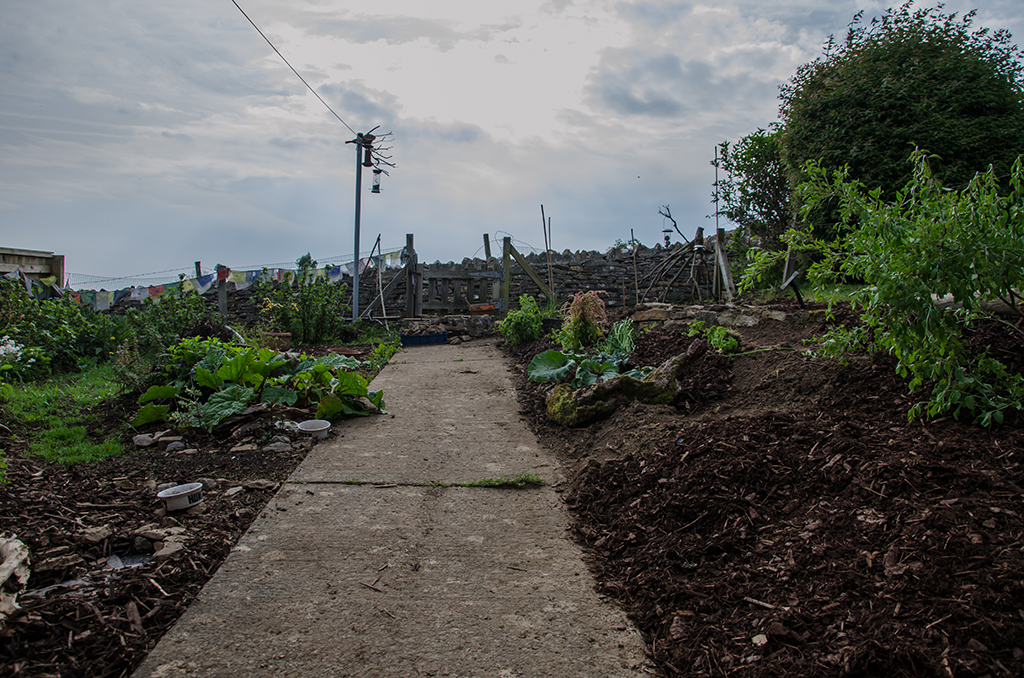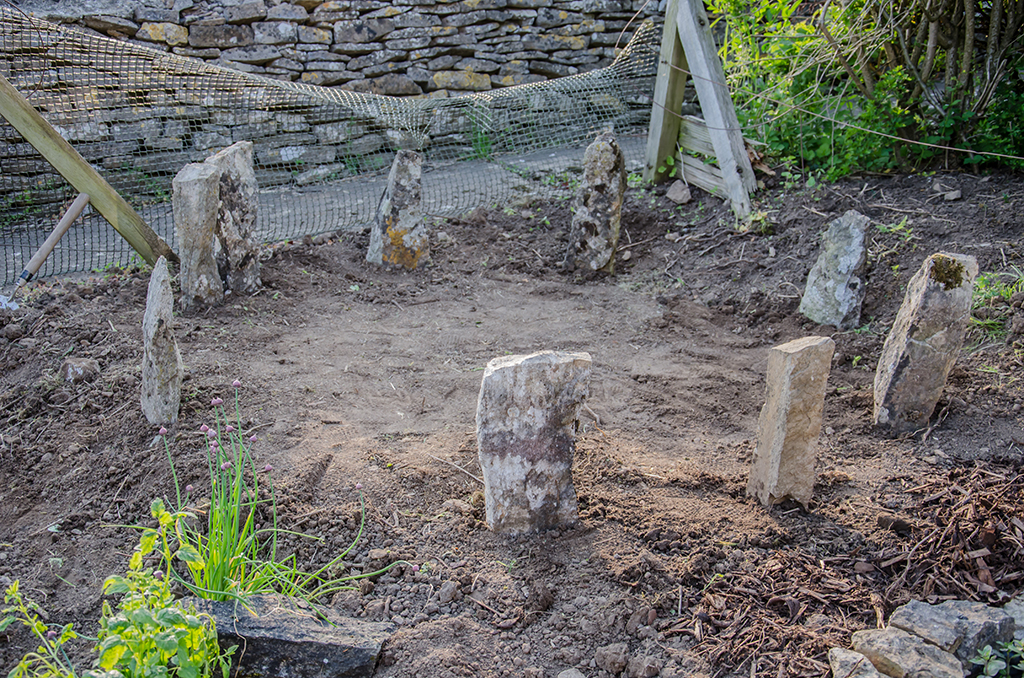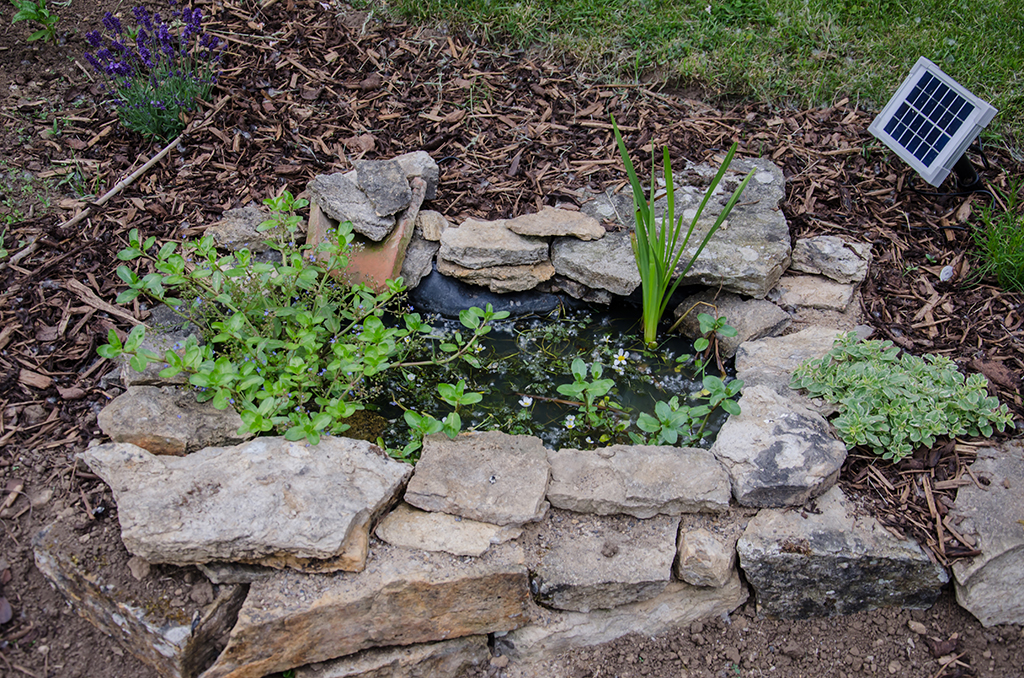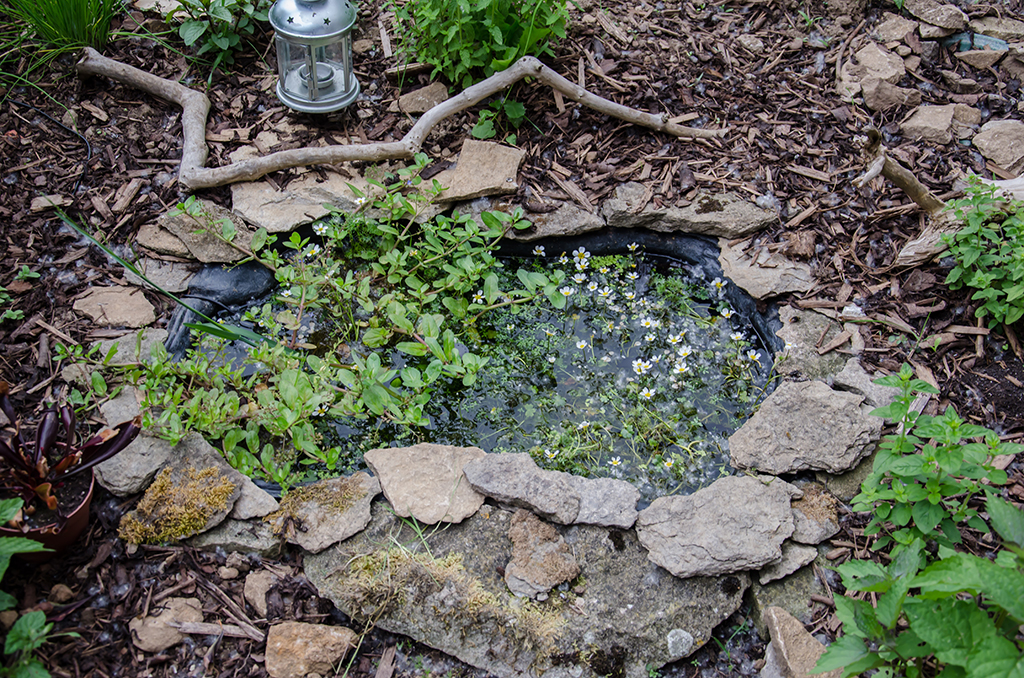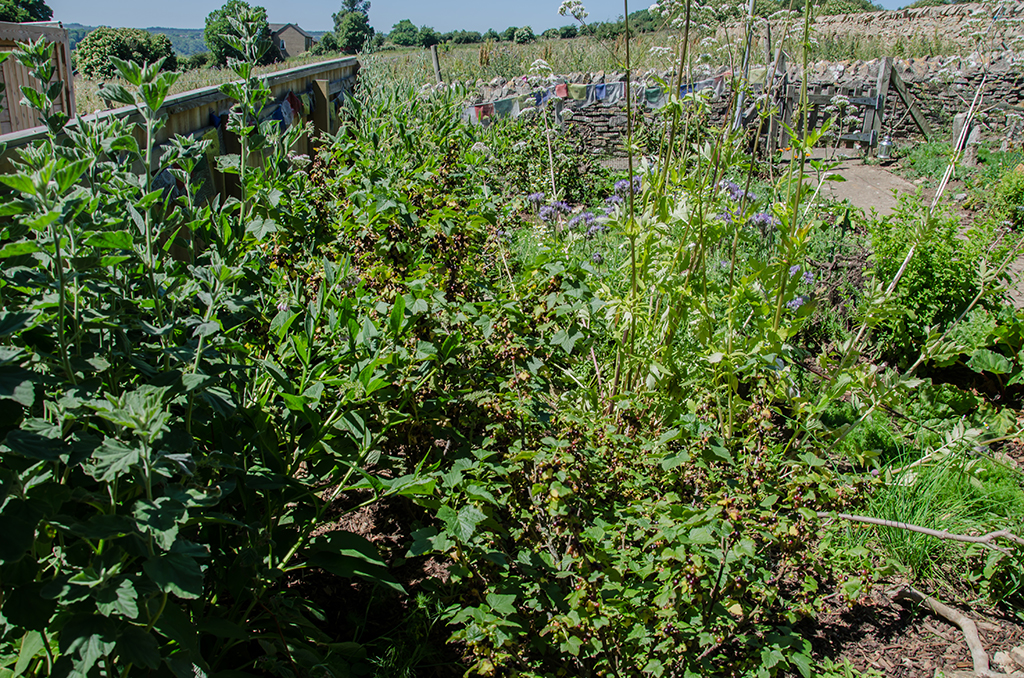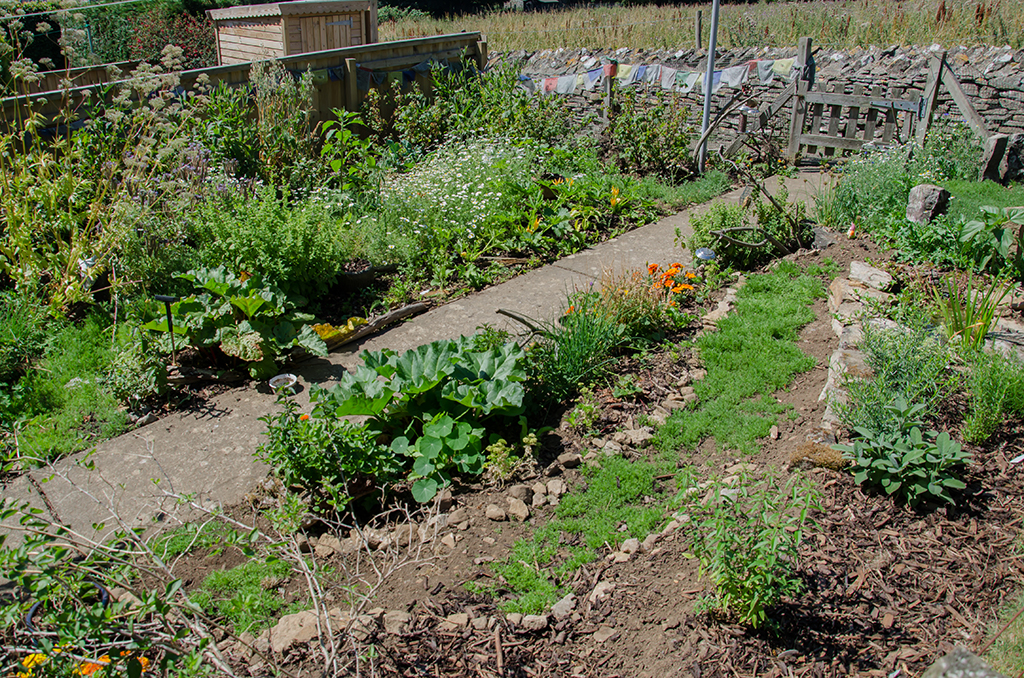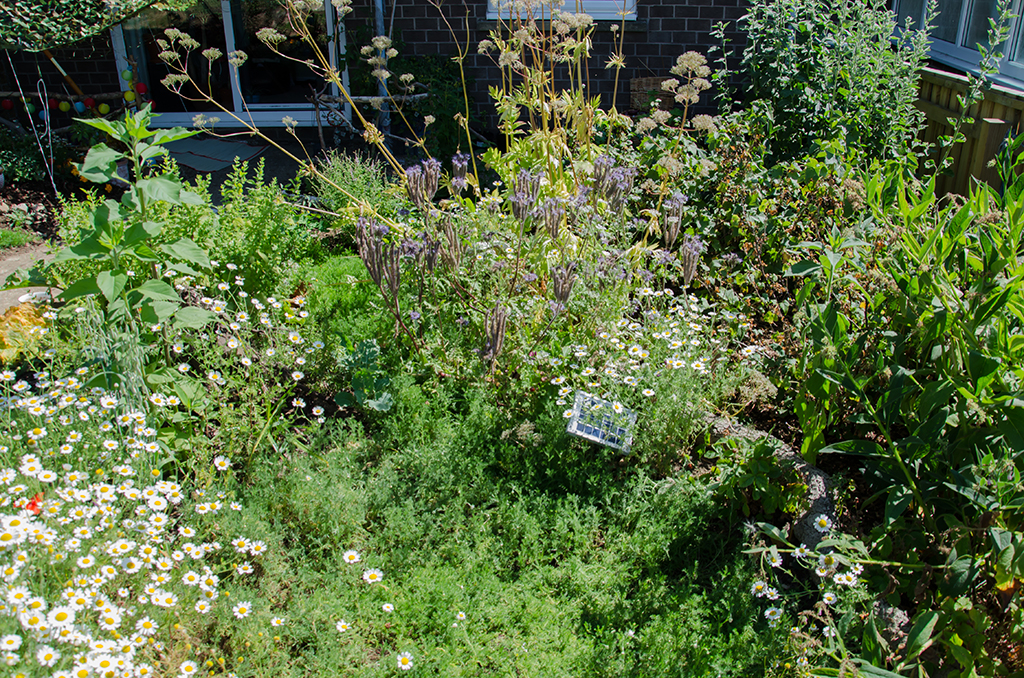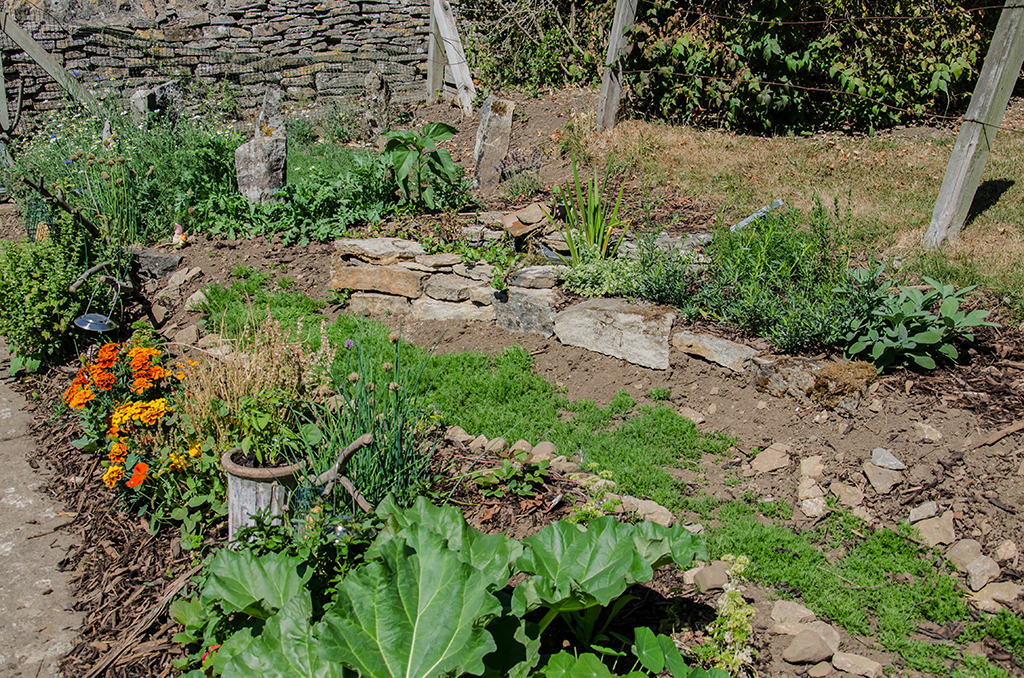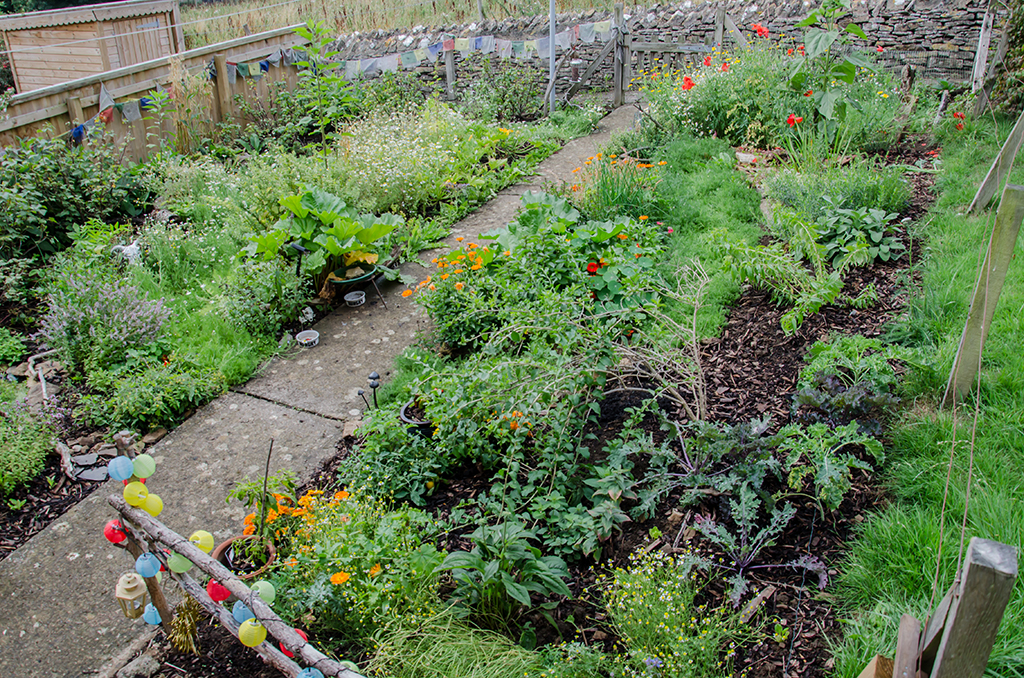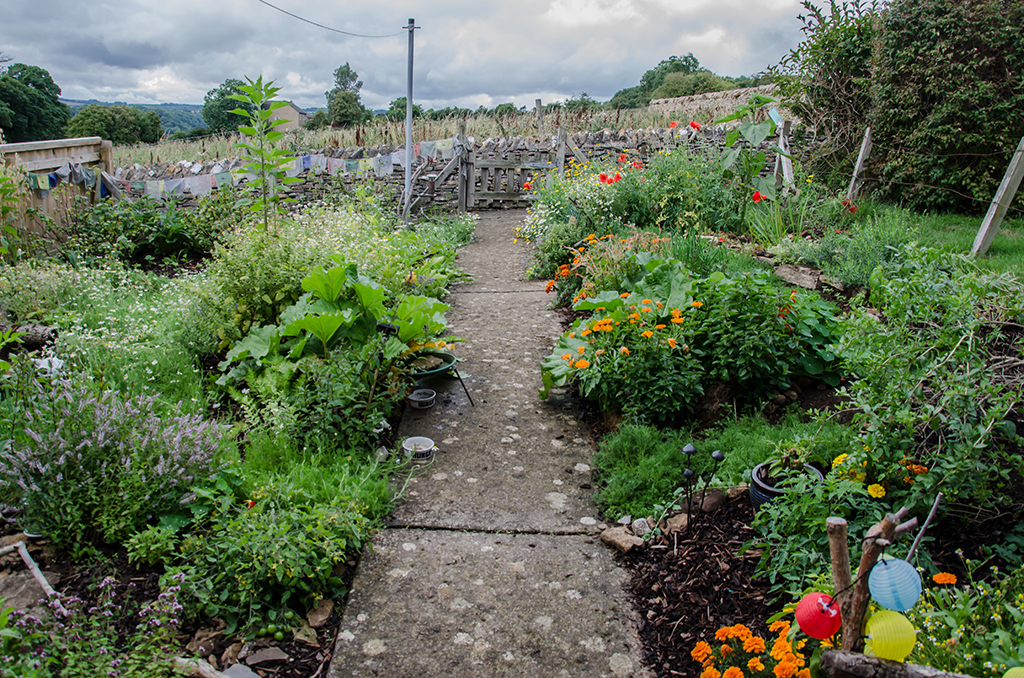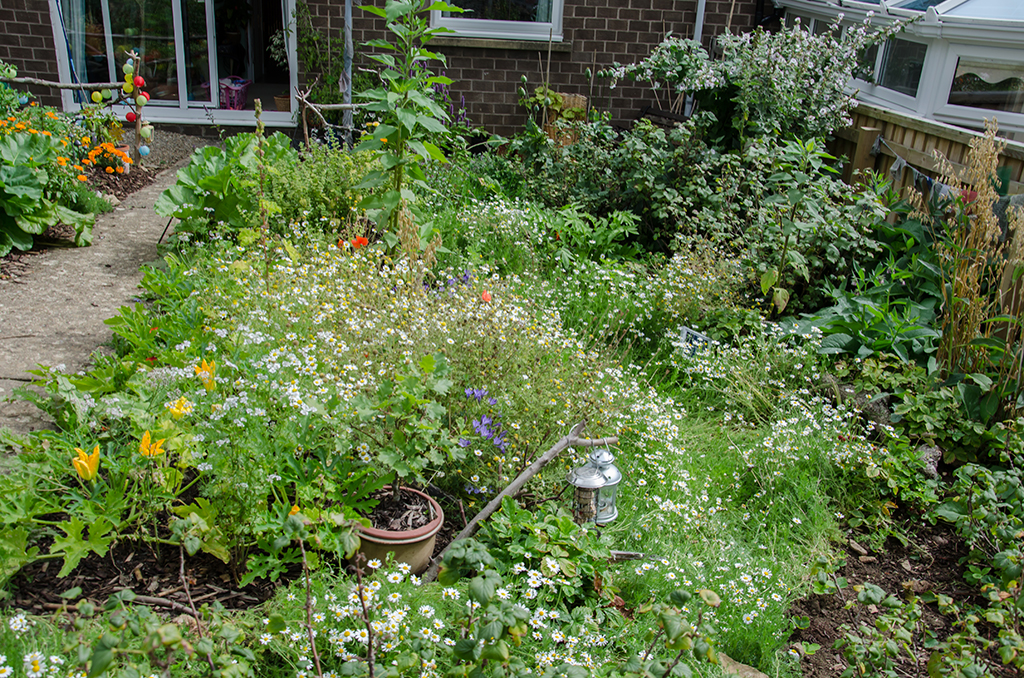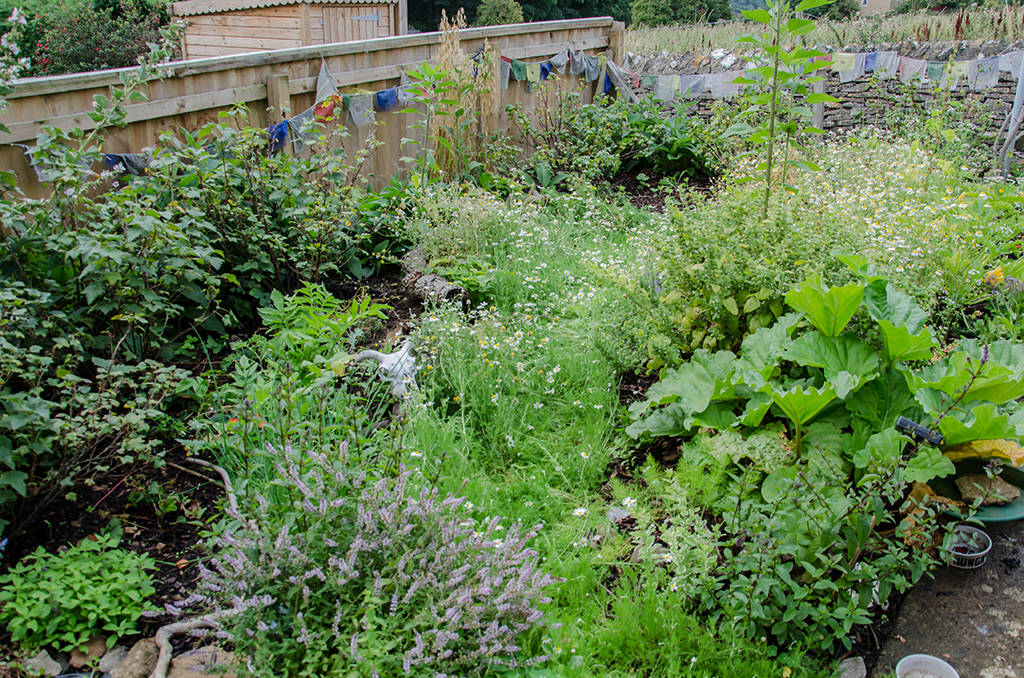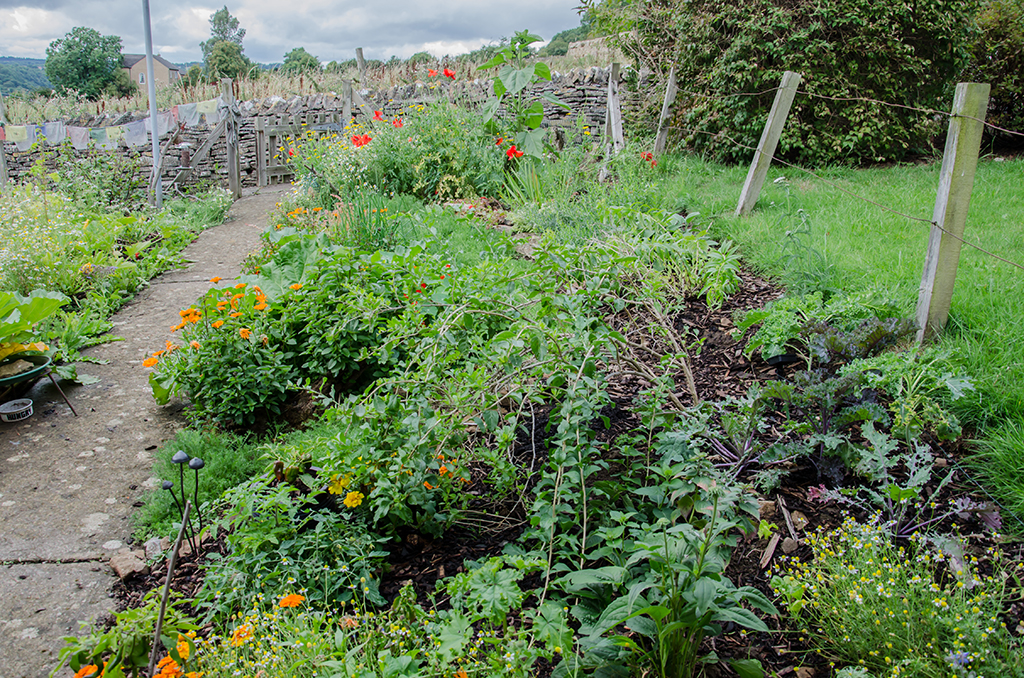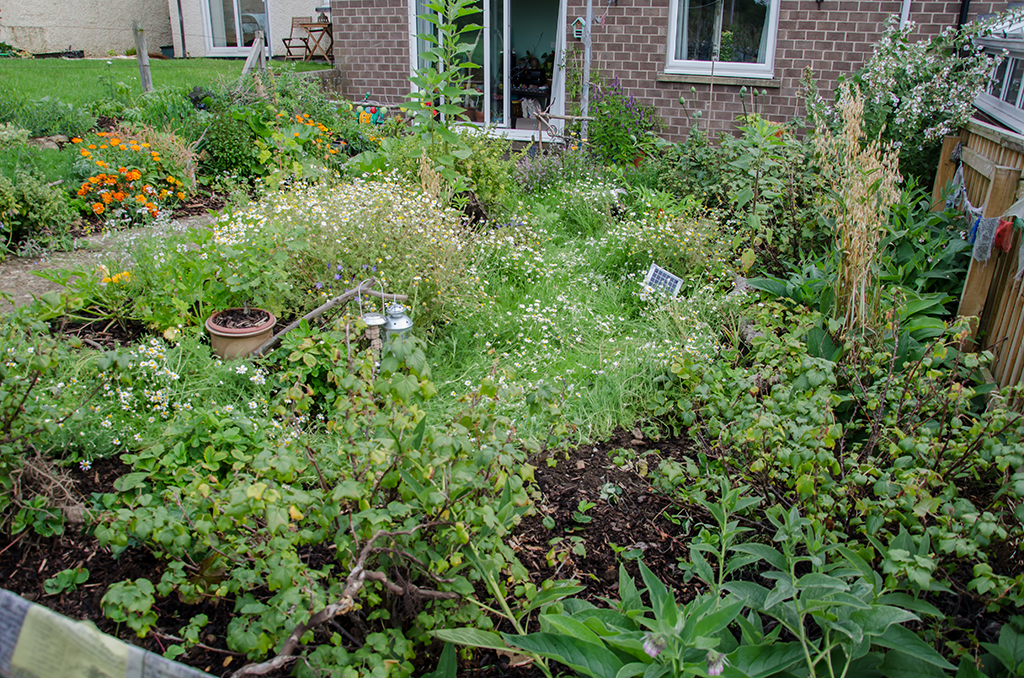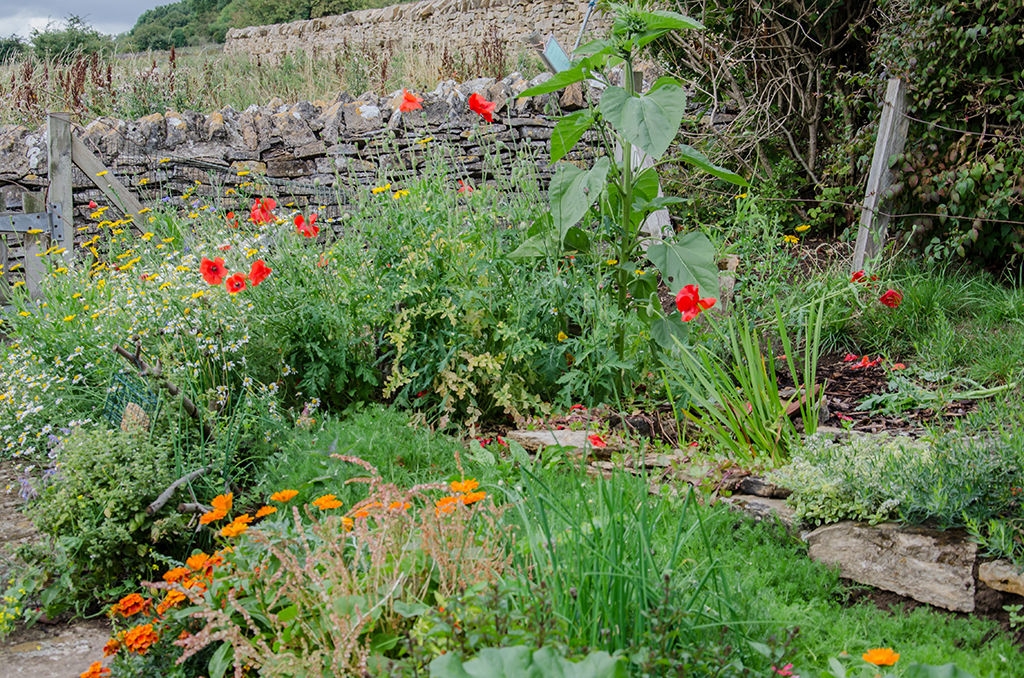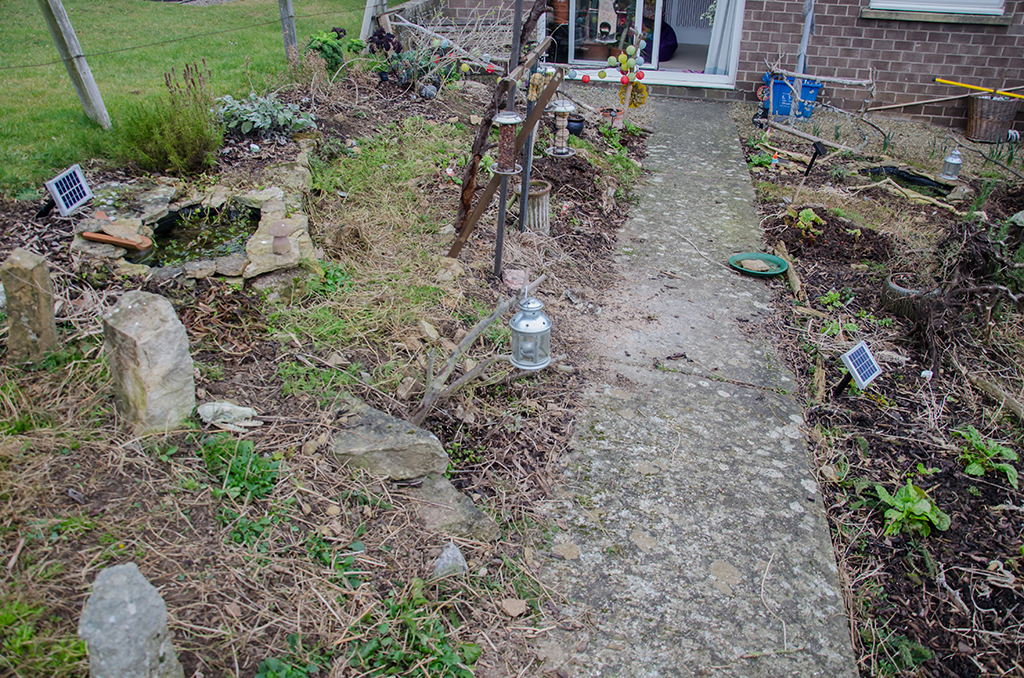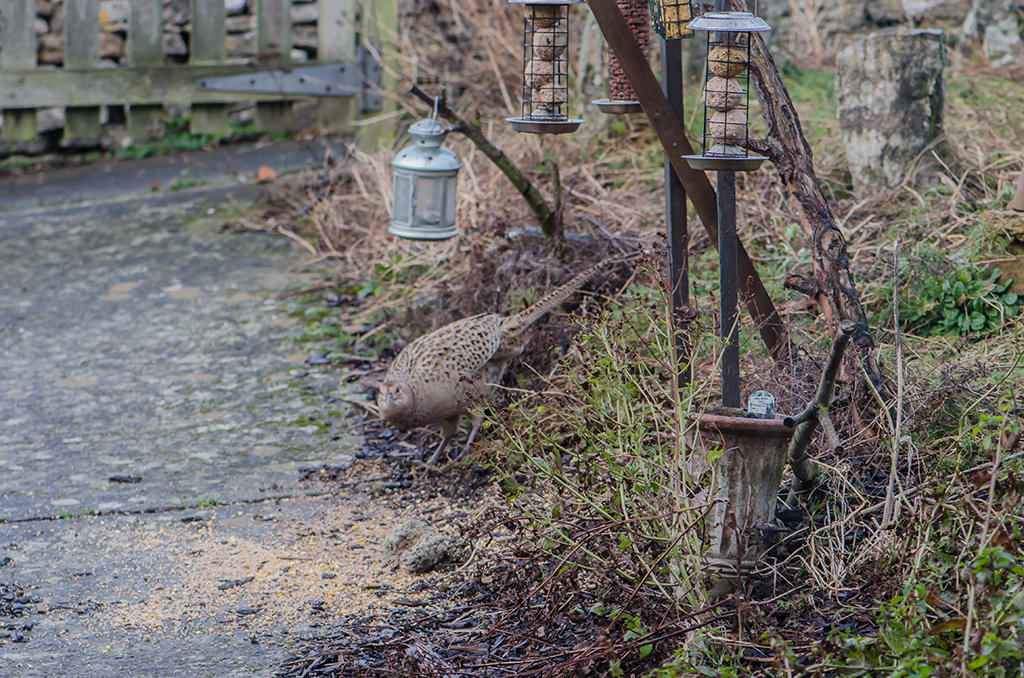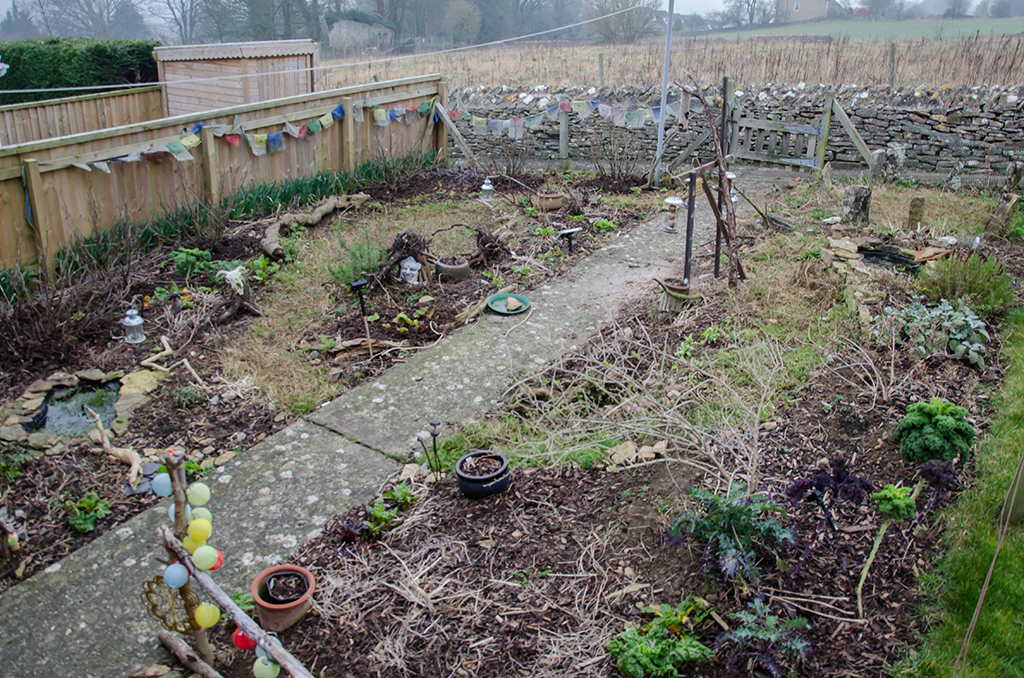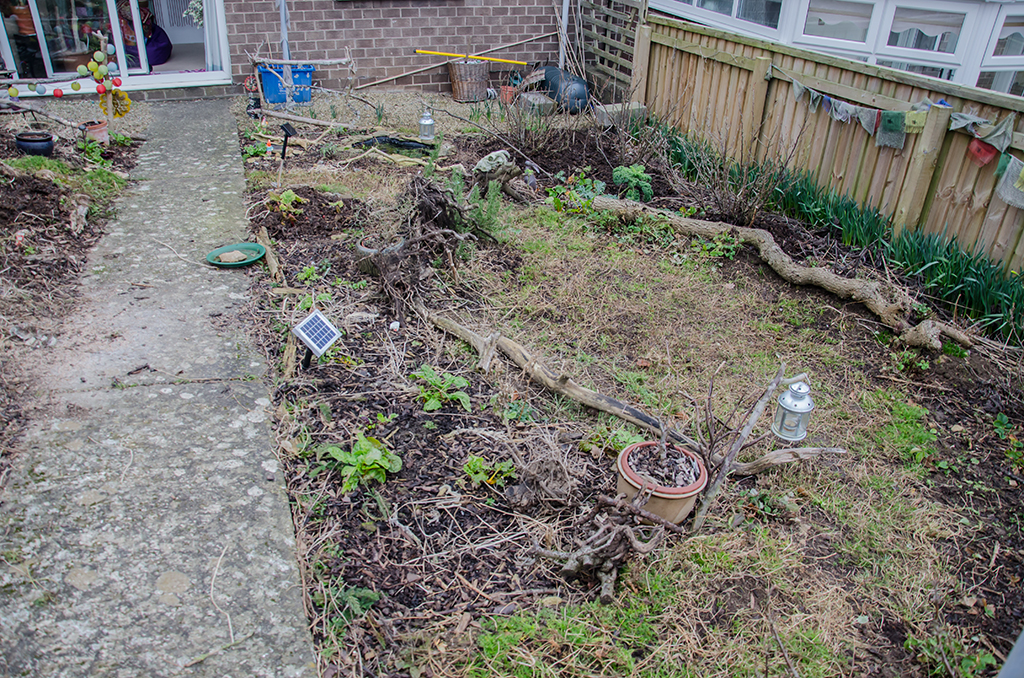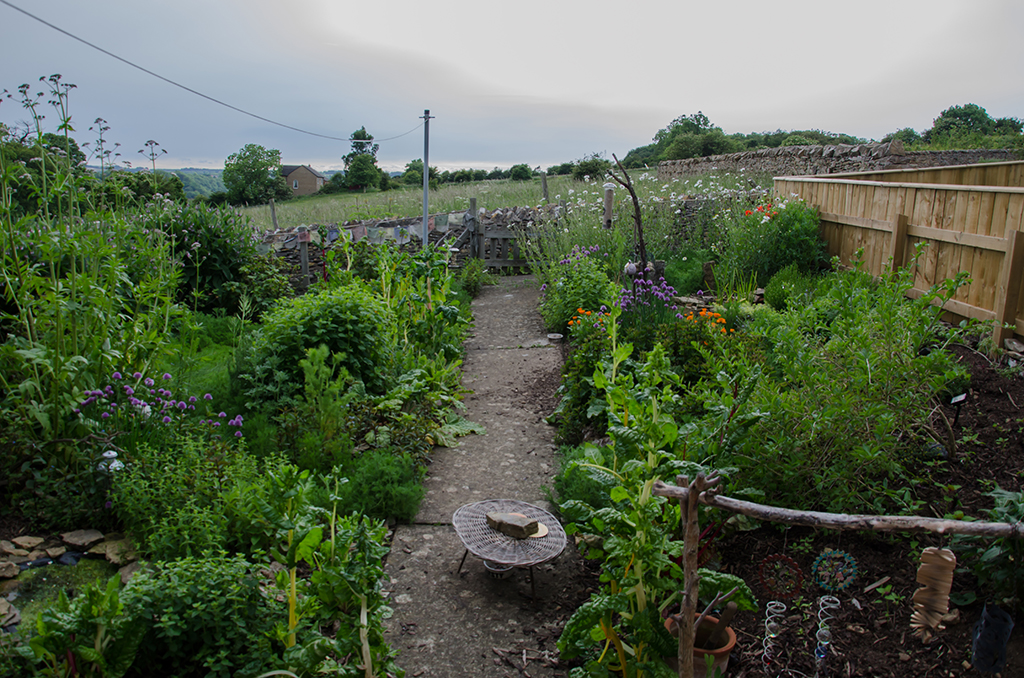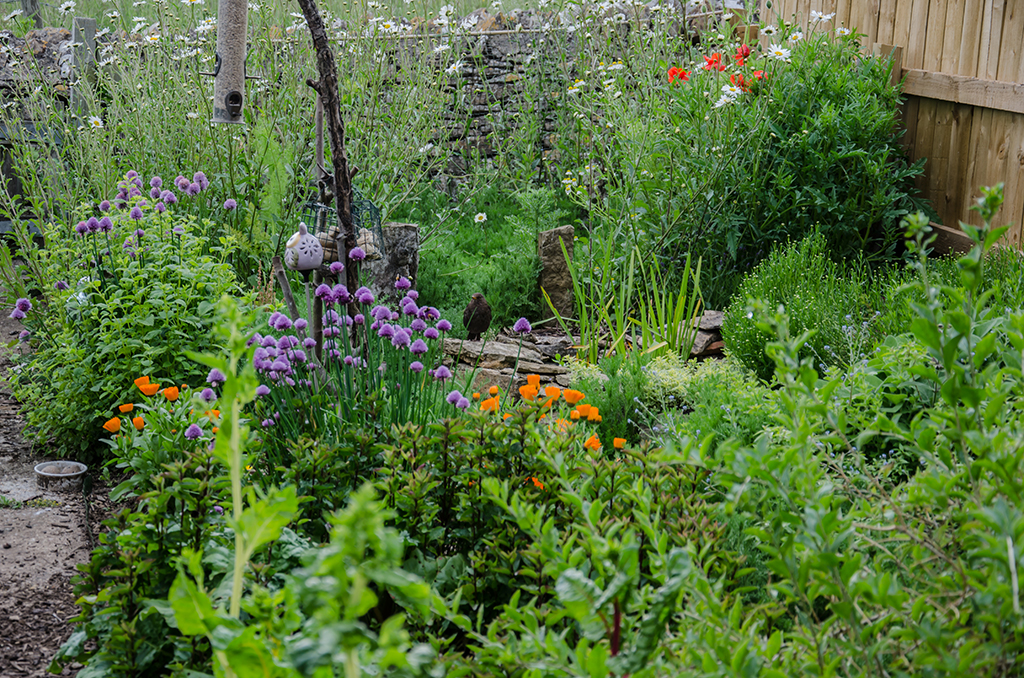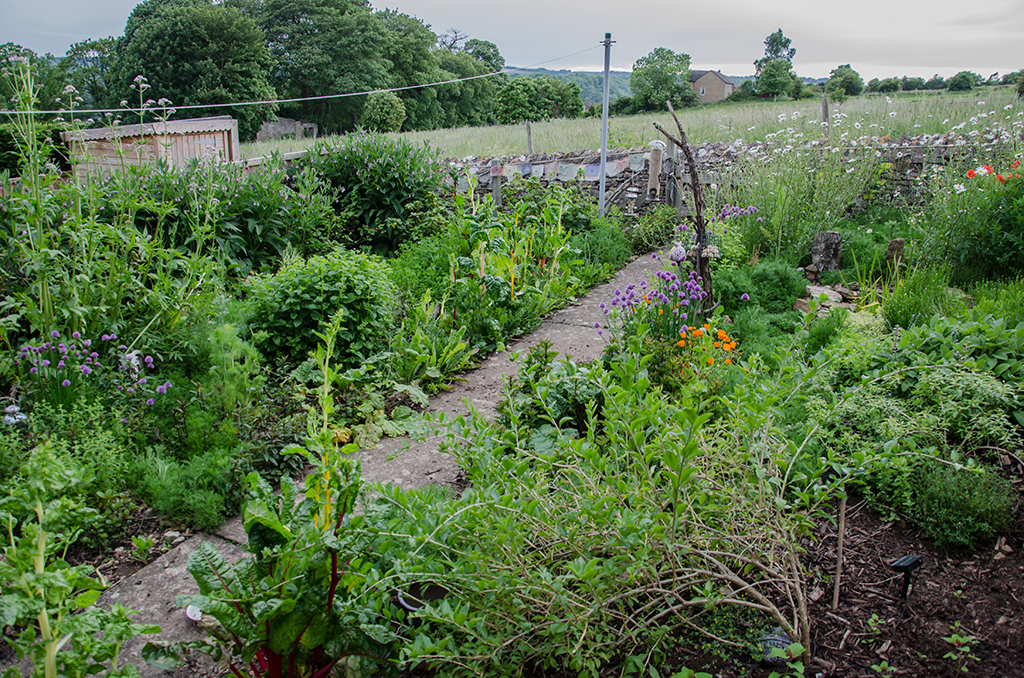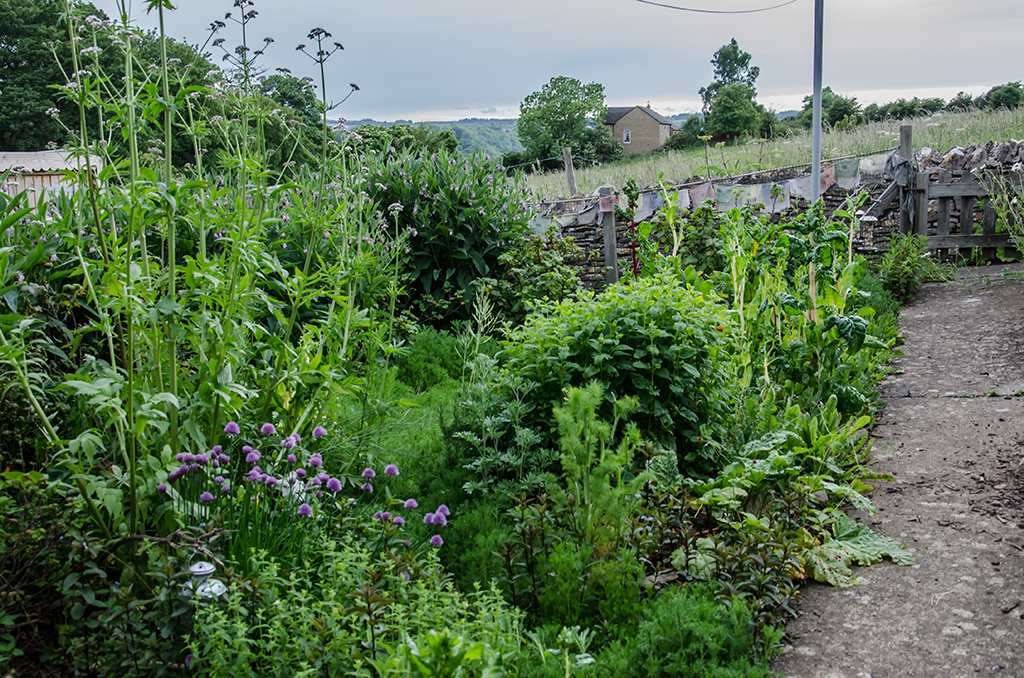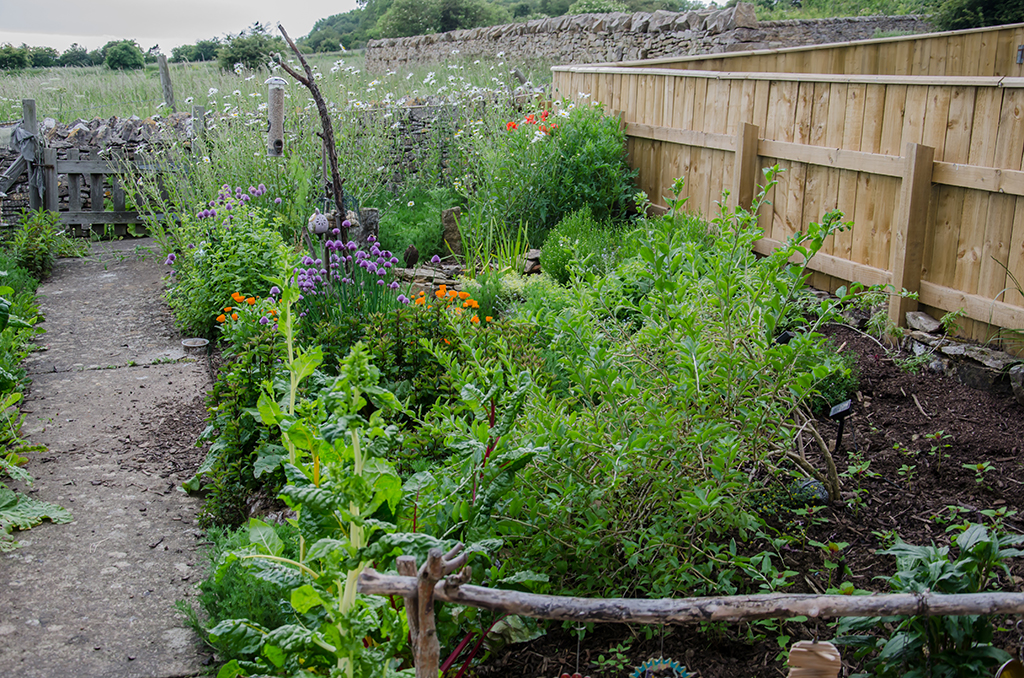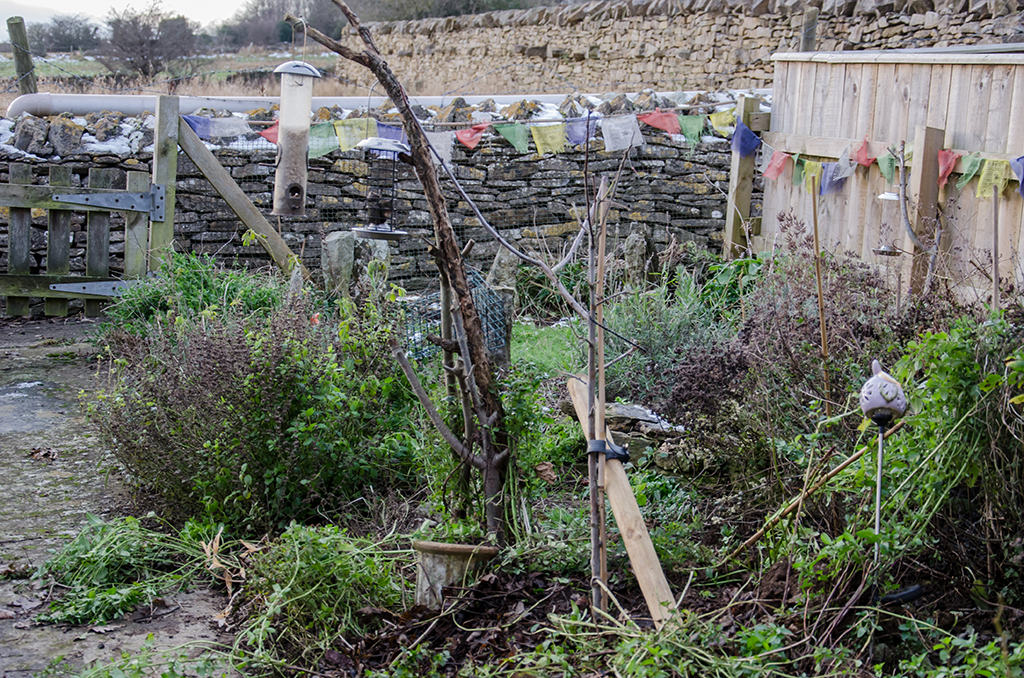Foraging Garden Design Re-Evaluation

December 28th, 2020
Well, what can one say about 2020?
My plans for the garden got side-tracked slightly due to working long hours with the job that pays all my bills. This year I never got the time to spend in the garden as I would have liked but that’s life for you.
To end the year on the 25th of December I planted a Victoria plum tree followed by a Lapins Cherokee Cherry tree on the 26th of December on rootstock: Gisela 5 (dwarf). The garden also had a couple more additions worth a mention, a dwarf Mulberry, along with a dwarf fig. this small space is certainly becoming the forest garden I have wanted so much to grow.
So as the year draws to a close it is time to ask those few questions to re-evaluate this design using a SWOC analyse to understand the Strengths and Weaknesses of the design, along with the Opportunities, and Challenges.
Strengths
Let’s start with the fruit bushes, after mulching with farmyard manure last Christmas the chuckleberries had an exceptional berry crop in 2020. In 2019 the blackberry bushes got attacked with aphids to the point they dropped their leaves early summer leading to a very poor berry crop. This year 2020 with the farmyard manure all three bushes put on excellent growth with very strong leaf cover and not a sign of aphids, the only downside was the bushes put all their energy into growth and produced very few berries. It is going to be interesting to see how they perform this next year. The raspberries seem to have established themselves a bit better this year putting out quite a few runners producing fruits into November.
The comfrey is now more than established, allowing me to cut it back three times with enough material to mulch other plants in the garden, I also was able to chop and drop lots of the mints and other plants in the garden this year allowing me to keep on mulching all summer.
I did get time to build a temporary trellis out of bamboo canes to grow Mashua over, towards late summer this gave me a place to hide behind and read without people on the footpath stopping to talk to me.
Another year on the soil is improving, last year I collected leaf fall from the car pack and gave the garden a deep mulch, this year I have done the same. Improving the soil is still one of the main focuses of the garden. Even with a very dry spring, I did not spend very much time watering the garden relying on the mulch to keep the soil from getting too dry.
Overall, this past year the plants are getting stronger and I have harvested leaves and flowers to dry for teas such as mints, chamomile, lemon balm, lemon verbena, and lavender. Along with different herbs for cooking.
The design is still working very well proving itself during another year when I was not able to spend as much time working in the garden.
From the perspective of the permaculture ethics, Earth Care, People Care, Fair Share, and how the original goals I laid out for these ethics in the design have played out, now 3 years on I can see all have been met with just the natural fluidity of the design. From the original design back in 2017, my vision for this garden has held strong.
Earth Care - I set out to create a habitat for wildlife, improve the topsoil, and grow food using only organic methods. This triad is a solid formula for earth care success. Healthy organic soil is the fundamental building block for our carbon-based life on this planet. From the macro perspective, this garden is an example of how looking after our soils creates the requirements for life to thrive allowing for a balanced environment. The blackcurrant bushes are a great example of what happens when soil is deficient in nutrients, the health of the plants became susceptible to illness, we see this when in 2019 all three bushes suffered greatly from aphid attack draining the sap from the pants to the point the plants went into survival mode dropping all their leaves in early summer. I observed what was going on and made a note to make sure I added manure to these bushes over the winter to help improve the soil microbiome which would give the plants a boost come spring. The result was very strong growth and not a sign of aphid damage in 2020. I knew that spraying the bushes with even organically approved pesticides would not prevent the aphids from coming back the following year, the problem was down to an unhealthy soil, improve the soil and improve the health of the plants.
People Care – Using the above example of looking after the soil to keep a balanced and healthy environment, a garden that thrives has a very positive effect on people. From the nutritional benefits of eating fresh organic foods to drinking teas made from leaves and flowers of the plants grown in the garden. It does not stop there; the garden has become a point of focus when people are walking past. I often see people stop to double-take all that they are seeing, be it all the plant growth or the stone circle. People take pleasure in looking into the garden. Often people will talk to me to ask questions about the garden or to just pass the time of day. This is People Care in action, once again viewing it on the macro level. Spending a few moments chatting to a passer-by whilst I’m pottering away in the garden can make a difference to somebody. In 2020 people have lost that connection to each other in the year of the fear pandemic. If this garden can stop people whilst they walk past on the footpath, even if to just have a nosy into the garden then the garden is doing its job talking to people.
From a personal need, the garden also gives me a place to express myself, to relax in and to journey through my thoughts.
Fair Share – Seeing the smile on Carol my neighbours face after passing her a few strawberries over the fence cost me nothing and rewarded me in ways money cannot buy. It is nice to hand over something from the garden to a neighbour or passer-by, people have lost the experience to be given things for just been in the right place at the right time. People Care and Fair Share are entwined in this garden, at times people have stopped to comment on the garden and I have got to hear people’s stories of their lives, stories of the town, things that leave me in wonder. The number of stories that have been shared over the garden wall makes me want to create more magic in the garden to entrance more people to share their thoughts with me.
During the colder parts of the year, I add bird feeders into the garden, also when the blackbirds are busy feeding their young I’ll put out mealworms, in return throughout the year I’ll watch wrens and tits moving through the fruit bushes picking off caterpillars and insects, the blackbirds will dig through the mulch taking slugs, I even had a song thrush this year visiting daily looking for snails, it takes me back to my childhood when finding broken snail shells from song thrushes was a common thing. It also makes me smile when my partner complains that she could not sleep because of the noise the hedgehogs were making in the garden during the night, it is good to know I have a night patrol working in the garden looking for slugs when I’m asleep.
Weaknesses
I still have a lack of shade in the garden and I really would like a permanent privacy area where I can sit outside and read without having to talk to anybody. I also really do need this next year to set up my rainwater catchment system. I would also like to make one of the ponds a little larger, they are just a bit too small for frogs to live in.
Opportunities
The addition of two fruit trees, dwarf mulberry, and fig this coming year should give me a little more privacy from the footpath. I am also looking forward to seeing more birds in the garden with the trees. This year with more height in the garden saw an increase in little birds. Next year with the two trees this should give the birds more cover to come and feed in the garden.
One of the highlights this year was watching a great spotted woodpecker feed its young as it sat on one of the stones of the stone circle, I also spotted a nuthatch popping onto the feeder several times. With the garden getting more established comes more and more opportunities for wildlife in the garden.
This next year I would like to add more magic into the garden. A good place to start is to bring the stone circle to life. Lots of children walk past the garden with their parents so I will try to give them something to look at that will perhaps encourage mum and dad to do something similar in their gardens. I also want to have some plants such as mints potted up to be able to give away, I am always pulling up mint to mulch so it makes sense to give it away.
Challenges
Probably the biggest challenge this next year is to add more shade. In the initial design, I was focused on keeping everything low due to the high winds with the garden open to the west. This never really turned out to be much of a problem due to the winds been taken over the house. I also wanted the sit in the garden and enjoy the lovely summer sun, not realizing I would be constantly looking for shade in the garden to get out of that lovely summer sun. On a south-facing slope, the sun gets very intense during the summer even here in the north of England.
Summary
Once again, I will go back to the original vision:
“To be able to forage for a wide selection of berries and herbs both culinary and medicinal from an environment that provides habitat for wildlife and brings calmness to the mind.”
With more and more wildlife both visiting and now living in the garden, our wildlife vision gets stronger year upon year and I am so happy to have added some trees which should give a good boost to the visiting birds. 2020 brought challenges outside of the garden so it was nice to finish work and sit and relax in a living space.
The vision lives on and I am looking forward to watching the garden grow into 2021.
Overall, I need to keep chopping back, keep improving the soil, and to find those plants that will provide me with the privacy and shade needed so I can sit back and enjoy the long summer days without passers-by all looking at me.
December 31st, 2019
Today I’ve added half a bag of farmyard manure around each of the fruit bushes. This year's berry crop was a fraction of the previous year. Thinking back to when I brought all six bushes from the allotment I dug them in with ample amounts of farmyard manure, I’m looking forward to seeing how this latest addition of manure has on next season's yields.
Whilst adding the manure today, I moved back the deep mulch of leaves gathered from the car park now covering the soil around the fruit bushes. The soil no longer resembles the heavy clay I dug into a little over two years ago to plant these bushes. If the soil structure keeps on improving like it currently is, in a few more years the garden will have soil that is capable of holding onto much more rainwater during the summer helping the plants to produce higher yields.
In 2019 the garden ran wild with masses of plants often preventing me access from walking around the garden on the paths. Before heading into this gardens' third growing season it’s time to take the opportunity to re-evaluate this design using a SWOC analyse to understand the Strengths and Weaknesses of the design, along with the Opportunities, and Challenges.
Strengths
The overall design layout of this garden has worked well. There is nothing in the layout that I would have done differently. The positioning of the fruit bushes on the slightly more shaded side of the garden worked well with the bushes producing around 7 kg of berries the first year. It’s looking like in 2020 the strawberry plants will have produced enough runners to be providing a good ground cover over the shallower soiled area of the garden. This past summer 2019, the whole garden was covered with plants, the comfrey seems to have established itself extremely well. The whole garden has if anything grew too well.
The ponds have added an excellent sound to the garden, one pond produces the sound of water trickling as the water runs over a clay pipe falling back into the pond, the other with the sound of water dropping into the pond from a small fountain. The birds have also welcomed the ponds as a favorite place to bathe in and drink from. We have several hedgehogs that pass through the garden each night in summer and come to drink from the ponds.
Day time in summer, the garden has been abuzz with insect life from grasshoppers to the many different bees, hoverflies, and wasps that come into the garden to feed on the flowers and hunt amongst the plants. Throughout the year birds are always around in the garden, I’ve seen song thrushes, pheasants, great spotted woodpeckers, and wrens to name but a few. As mentioned we have a healthy population of hedgehogs that pass through the garden during the summer months, they can be heard both mating and fighting with each other during the night. We have many owls that frequent the large ash and sycamore trees not far from the garden though I have not seen any owls in the garden I would no be surprised if the owls come to hunt the many mice that also now live in the garden.
Weaknesses
There are a few weaknesses that I see in the garden. The first is that I have not yet created that place of solitude away from the people walking past on the public footpath.
Secondly, I have no shade in the garden without having to set up a large sun umbrella. Originally I envisioned sitting in the garden in full sun was going to be great, in reality, the garden gets so hot that I often have to move into the front garden and sit in the shade of the house.
Thirdly, after this year's poor returns on the fruit bushes, I suspect I need to be adding extra fertility into the garden. This is why I’ve already mulched the whole of the garden with leaves gathered from the car park and given the fruit bushes a few bags of farmyard manure.
Opportunities
With the weaknesses come the opportunity to create that space of solitude and shade, I am still looking for the right thing to plant near to the house where I often sit. This will have to be something that can provide me with both shade and privacy but also produces food or another useful crop.
Challenges
Not to let the garden get out of hand this next growing season, this will involve sticking to the weekly maintenance plan of chopping and dropping anything that has the potential to take over an area of the garden.
Summary
Starting with the vision:
“To be able to forage for a wide selection of berries and herbs both culinary and medicinal from an environment that provides habitat for wildlife and brings calmness to the mind.”
The design has the makings to provide this vision, as the soil improves I’ll be able to grow a wider variety of plants providing I do not let certain ones take over the garden.
The wildlife that the garden has encouraged into it is wonderful. It's a joy to sit in the garden during the day, both listening and watching all that is going on and not to forget hearing the hedgehogs roaming about during the night.
Overall, I need to keep chopping back, keep improving the soil, and to find those plants that will provide me with the privacy and shade needed so I can sit back and enjoy the long summer days without passers-by all looking at me.
Re-evaluation - The Pictures
November 2017
November began with the removal of the existing shrubs from the garden, this involved the cutting down and digging out of the roots to avoid any regrowth. All the wood from the shrubs was cut into small pieces and stored under a tarp to be used as fuel for future fires. (note two years on and I still have all this wood under the tarp still).
December 2017
Phase One Day One
Phase one of the garden design is to work on the left-hand side of the path where the fruit bushes are to be planted. Getting started on this phase is time-critical due to needing to dig up the fruit bushes along with any other plants from the allotment whilst I can still gain access to the allotment car park that once wet becomes a bog. All the plants and bushes from the allotment will be planted into the new garden. I also need to be conscious of snow and hard frosts preventing me from moving plants from the allotment. Taking a week off work at the beginning of December to start work on the design came with a risk of the weather stepping in and preventing any work.
To begin I racked back all the gravel from the soil and removed other obstacles from the garden leaving a blank canvas to work from.
December 2017
Phase One Day Two
Day two was spent digging off the lawn sod ready for finding the contour of the site.
December 2017
With the lawn now all removed, I used the a-frame to remark out two contour lines that will help to level the site and hold water in the soil. As a side note, when drawing the base map before the removal of the lawn I marked out where these two contour lines would go, mistakingly I then removed the markers to dig off the lawn leaving only where the lines would start and then end. After removing the lawn I then remarked out the lines again, on hindsight I should have left the original markers in because with the lawn removed I had to spend time leveling the surface to make sure I was correct with the contour, this was a very time-consuming task and a good learning curve. When I started the second phase I left all the markers for the contour lines in the garden and worked around them. this made removing the lawn a little tricky but much easier than trying to work out where markers should go after the soil has been removed.
Once the contour was marked out with string I dug out a trench following the string, backfilled it with the lawn sod, compacted it down, then using the soil dug out created a mound on top once again following the contour marked out with the string.
This now left the garden with three levels.
December 2017
Phase One Day Four
After getting to the allotment at first light and the weather still good, I made quick work on removing enough fruit bushes and other plants for a full load in the car.
Once the three fruit bushes and the other plants were unloaded into the garden work began on getting everything planted out.
December 2017
Phase One Day Five
I was back to the allotment at first light for the next load of fruit bushes and plants and followed the same procedure as the day before.
I also dug another trench back-filled with lawn sod and mounded the soil to separate the growing area from the gravel area. This was slowed down due to the number of daffodil bulbs I found. I had already ordered a small bag of daffodil bulbs to go along the side of the fence, so I kept all these bulbs to also add along the fence.
December 2017
Phase One Day Six
I levelled out the area in the middle of the garden where a chamomile lawn was to be laid, with a path running out each side back to the concrete path.
I also planted any remaining plants from the allotment along with the Bocking 14 comfrey roots that I planted near to the fence. (see appendix) Later in the day, the small bag of daffodil bulbs I ordered turned out to be a very large sack. After much thought, I decided to dig a trench along the side of the fence and tip the lot in along with the bulbs I already had dug out the day before. (see appendix)
March 2018
A few days after my week working in the garden in December, the weather turned. We had the longest winter for many years with lots of snow on the ground for most of the winter.
March came with a gradual rise in temperatures and slowly the garden began to wake up.
8th April 2018
With the soil now accessible after all the snow, I’ve been able to add a mulch of wood bark chips over the garden.
With all six fruit bushes are beginning to come out in leaf the hard work back in December certainly paid off.
15th April 2018
With the addition of a few bags of compost over the area where the chamomile lawn and paths are to go, I got the whole area sown with chamomile seeds.
19th April 2018
I bought this small pond back in December but ran out of time before the snows came to get it in the ground. Finally, I’m now able to get it set up.
22nd April 2018
After a trip onto the moors to a pond I’ve been monitoring for many years to see when the frogs and toads spawn, I collected a bucket and filled half with mud from the pond bottom and the rest of the way up with various floating plants. Once back home I added this to the new pond creating a wildlife pond as natural to this area as possible. To keep the pond airyated, I added a solar fountain.
May 2018
The daffodils have certainly taken kindly to their new home, the large sack worked out well.
The fruit bushes are coming into flower, the comfrey is also starting to show. Everything planted so far has taken extremely well and I now have the makings of the garden laid out in the design back in November last year.
Phase Two May 2018
With the help of the A-frame, I marked out the contour line for where the garden would be divided up into slightly flatter segments, helping in slowing down the rainwater from just running off the soil when it rained.
With the contour marked out and the location of where the path is going also marked out I set about digging off the lawn sod.
Once all the lawn was removed, I added a second small pond on the highest point in the garden.
Next came the digging of two trenches along the contour lines and backfilled with the lawn sod with the dug-out soil been placed on top creating a mound running the length of each contour.
To prevent the soil holding the pond in place from getting washed away from heavy rains I added several large rocks forming a short wall running along the marked-out contour line.
The path was now leveled out and any plants I already had growing in pots were planted out.
A mulch of several bags of bark wood chips were placed over the soil leaving the paths uncovered.
After so much hard work came some fun in marking out the locations for each of the stones to create a 9-point stone circle. The double stones mark the location of the setting sun of the winter solstice, along with single stones marking the rising of both the winter and summer solstice sun, and the setting summer solstice sun. Each of the stones has been gathered locally from areas I walk each week.
With the stones set in the ground, I then sowed the circle and the path with chamomile lawn seeds along with some wildflower seeds on the outer side of the circle.
Early June 2018
With little to no rain for a few months and one of the hottest early summers in many years, it’s been a time-consuming job trying to keep some moisture in the soil especially to allow the chamomile seeds to germinate and grow. The garden certainly benefited from this hard work with all the plants holding out and growing with vigour.
Both ponds soon got established probably due to using the local pond mud and plants to create an instant environment for life.
Late June 2018
With the dry weather continuing and the hot summer sun ripening the berries all at once, harvesting around 7kgs of blackcurrants and chuckleberries was a huge task to do on my own, never the less the bushes produced amazingly after been transplanted from the allotment into the garden only 6 months ago.
Mid July 2018
And still, the sun shines every day.
Mid August 2018
It was nice whilst it lasted but the rain was badly needed, it’s hard to believe the transformation that has taken place in this garden these past few months. The chamomile lawn is in full flower along with many other plants, the garden is abuzz with insect life where there was once only silence. So far so good.
Mid September 2018
Slowly the garden is starting to turn, even now I’m amazed at how well the garden has looked in its first year.
November - December 2018
Time to cut back those plants that are now only shadows of the summer past.
February 2019
The bird feeding station now gets a daily visit from a hen pheasant, a bird I didn’t expect to see in the garden. I’ve also had the great pleasure of being in the garden when a great spotted woodpecker paid the bird feeder a visit.
I’ve also added some of the homemade compost around the fruit bushes to hopefully give them a boost for the season ahead.
June 2019
Now into its second year, the garden is growing better than ever.
July 2019
It’s wild, the garden this year has certainly got away from me. It’s surprising how fast it can suddenly become so wild that I can no longer walk through it.
August 2019
I now look out at this jungle and see a mass of organic material that will soon go back into the soil. It’s going to be interesting to see how the soil has changed in 2020 from the time this design started in 2017.
Summer 2020
Strong plant growth allowed the plants to get even more established this summer, with the addition of the chop and drop method of allowing plenty of plant mulch back onto the soil to feed the soil microbes which in turn will feed the plants once more.
Winter 2020
To end 2020 the garden welcomed the addition of two fruit trees, a Victoria plum and a Lapins Cherokee Cherry both on rootstock: Gisela (dwarf).
